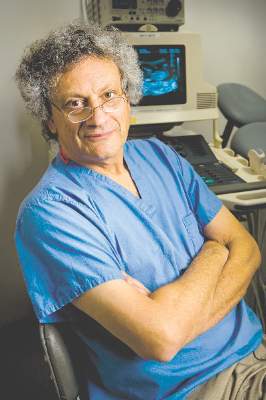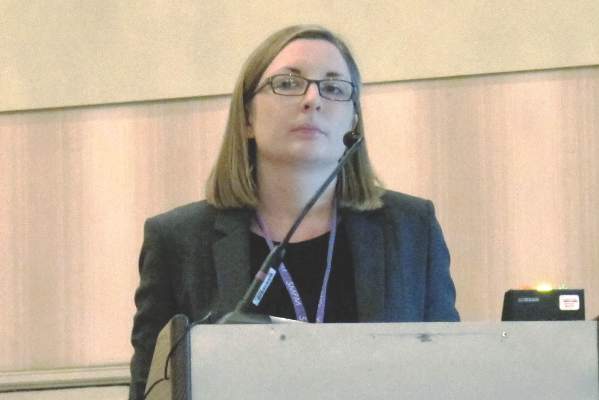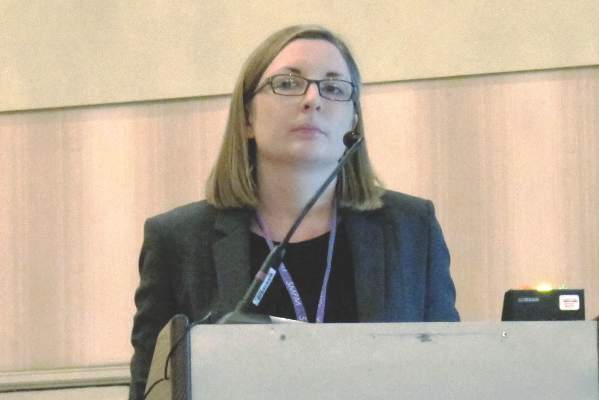User login
Prenatal genetic testing opens new doors for diagnosis, treatment
ATLANTA – New advances in prenatal genetic testing are rapidly expanding the catalogue of known genetic anomalies, and the tools to detect them.
“At one time, not too long ago, we were naive enough to think that the x,y picture was enough,” Dr. Ronald J. Wapner said during a day-long seminar at the annual Pregnancy Meeting sponsored by the Society for Maternal-Fetal Medicine. “In 1979, we as a field made a decision to use karyotyping to screen for Down syndrome. Now almost half a century later, we are still screening for Down, but our technology has dramatically changed. Virtually all chromosomal aberrations can now be detected by prenatal testing.”
It’s not just the technology that’s expanding, though. An ever-increasing number of chromosomal and subchromosomal anomalies can now be detected with up to 100% accuracy. It’s true that not all of these are known to be clinically relevant, said Dr. Wapner of Columbia University, New York, and many of the genetic variances may have no clinical significance at all. But as testing and diagnosis mature, he anticipates uncovering new links between genetic findings and their physical and neurocognitive manifestation.
“As we learn, there will be things that we can identify that will matter,” he said. “And the time to find out about that is before the baby is born, when parents still have time to make important decisions about how to handle the pregnancy.”
New data suggest that copy number variants are much more common than once believed. For example, in prior general prenatal studies that looked at testing for advanced maternal age or maternal anxiety, the incidence of 22q11.2 deletion was about 1:800. But Dr. Wapner has reason to believe that microdeletions associated with neurocognitive problems may be much more common than is now assumed.
He conducted an analysis of one of his own studies, which compared microdeletion detection using both karyotyping and chromosomal microarray.
In this analysis, which is currently unpublished, he found that among children with neurocognitive delay or dysmorphic features, the 22q11.2 deletion microdeletion, which is strongly associated with schizophrenia, appeared to be much more common – 1:167. Similarly, a microdeletion in 16p11.2, associated with autism, that occurred at a rate of 1:976 in the prenatal studies, was closer to 1:241. There were similar findings for copy number variants associated with epilepsy, Prader-Willi, and Angelman syndrome.
Some striking numbers illustrate the expansion of both the ability to test and to understand the results. Dr. Wapner presented genetic analysis data on 3,822 patients tested from 2008 to 2014; these patients had a total of 165 copy number variants. In the initial period of 2008-2011, 2.5% of those were of unknown significance; 0.9% were known to be pathogenic, and 0.9.% were benign. Over the subsequent years, the numbers of variants categorized as pathogenic or benign didn’t change, but those of unknown significance did – and they did so rapidly.
In 2012, the percentage of variants of unknown significance dropped an entire point, to 1.5%. It decreased further in 2013 (1.2%), and again in 2014 (0.9%). The steady decline shows that geneticists just aren’t finding new things, but are understanding them as well.
Testing risks decline
Obtaining fetal genetic material by amniocentesis or chorionic villus sampling (CVS) is not without risk, although those risks are probably lower than previously believed.
A 2015 review examined outcomes in more than 51,000 women who underwent amniocentesis or CVS. There were 324 pregnancy losses in 42, 716 women who underwent amniocentesis and 207 losses in 8,899 women who underwent CVS. The risk of miscarriage prior to 24 weeks in women who underwent amniocentesis was 0.8%; it was 2.18% in the CVS group.
“We have all had procedures where a patient has lost the pregnancy,” Dr. Wapner said. “But the risk is lower than we even had thought. With amnio it’s about 1 in 1,000 and with chorionic villus sampling it’s about 1 in 500.”
Advances in blood-based sampling may someday obliterate any risk to the pregnancy. Dr. Wapner foresees a not-too-distant future when a simple maternal blood draw will make fetal genetic screening a viable option for every pregnancy, and not just reserved for the pregnancies of parents with known genetic risk factors.
Cell-free fetal DNA freely circulates in maternal blood and even now is being used to detect some of the more common aneuploidies, including trisomies 18 and 21, Dr. Mary E. Norton of the University of California, San Francisco, said during the seminar.
Her 2015 studycompared the accuracy of trisomy screening with cell-free DNA to standard ultrasound (crown-to-rump length and nuchal translucency) in trisomies 21, 18, and 13. For trisomy 21, specificity was similar between the methods (99% vs. 95%), but sensitivity was significantly better (100% vs. 79%). Negative predictive value was similar as well (about 100% for each method), but the cell-free DNA blood test performed significantly better in terms of positive predictive value (81% vs. 3%).
Cell-free DNA testing also performed better for trisomies 18 and 13, although the results were not as dramatic.
Accurate, low-risk prenatal genetic testing is a must, Dr. Norton said. A 2014 study of 31,000 pregnancies illustrated this. Cell-free DNA testing found 507 fetuses with high-risk results; 6% of these pregnancies were terminated without confirmatory karyotyping. “This is disconcerting,” especially if the positive predictive value is not high, she said.
If large-scale screening were implemented, even a 1% false-positive rate could spur sobering consequences. That would flag 1,000 at-risk fetuses in every 100,000 tests. Assuming that the positive predictive value was 68%, if 6% of these pregnancies were terminated without karyotype confirmation, 20 normal fetuses could be aborted, Dr. Norton estimated.
Fine-tuning noninvasive tests
Dr. Wapner is confident that maternal blood testing will quickly become a fine-tuned instrument for detecting fetal aneuploidy, and that it will become an accepted part of prenatal care. It can be extremely helpful in the cases of de novo mutations – the completely unpredictable chromosomal abnormalities that account for more than 90% of genetic defects. Some of these problems can be corrected soon after birth, and some can even be treated or eliminated prenatally. And those that can’t, he said, could be detected in plenty of time to allow careful consideration of how to proceed with a pregnancy.
Brown-Vialetto-Van Laere syndrome 2 (BVVLS2) is an excellent example of this potential, said panel member David Goldstein, Ph.D., of Columbia University, New York. He described one of his patients, an 18-month-old girl who would have died if whole-exome sequencing had not identified this as the cause of her devastating neuromuscular decline.
BVVLS2 is caused by a mutation of the SLC52A2 and SLC52A3 genes, which encode for proteins that facilitate transmembrane riboflavin transport. The disorder is exceedingly rare: only 90 cases have been recorded. It’s also exceedingly hard to diagnose, since it presents a panoply of symptoms including sensorineural deafness; breathing problems; muscle weakness in the face, neck, shoulders, and limbs; spasticity and exaggerated reflexes. It presents at various times, progresses rapidly, and is typically fatal.
However, BVVLS2 can be quite simple to treat using high doses of riboflavin. The aim is to keep circulating levels so high that some of the vitamin does end up in cells, usually transported by alternative pathways, said Dr. Goldstein.
The patient presented with sudden-onset nystagmus and was initially diagnosed with an unspecified autoimmune disorder. But she failed to respond to corticosteroids and cyclophosphamide. She developed rapidly progressing neuromuscular symptoms, including gait difficulty, head tilt, and drooling.
Whole-exome sequencing identified the inherited BVVLS2 mutation. She was immediately started on high-dose oral riboflavin, with improvement noted in 2 weeks. She continues to improve and be on target with all her developmental milestones, Dr. Goldstein said.
This is a perfect example of a case where prenatal diagnosis could have resulted in early treatment, avoiding all of the problems this patient experienced, Dr. Wapner said.
“This kind of testing lets us move beyond having only two options – keep or terminate. It really is the beginning of personalized medicine for the fetus,” Dr. Wapner said.
None of the researchers mentioned in this article reported having any relevant financial disclosures.
Watch a video interview on the future of prenatal genetic screening here.
The video associated with this article is no longer available on this site. Please view all of our videos on the MDedge YouTube channel
ATLANTA – New advances in prenatal genetic testing are rapidly expanding the catalogue of known genetic anomalies, and the tools to detect them.
“At one time, not too long ago, we were naive enough to think that the x,y picture was enough,” Dr. Ronald J. Wapner said during a day-long seminar at the annual Pregnancy Meeting sponsored by the Society for Maternal-Fetal Medicine. “In 1979, we as a field made a decision to use karyotyping to screen for Down syndrome. Now almost half a century later, we are still screening for Down, but our technology has dramatically changed. Virtually all chromosomal aberrations can now be detected by prenatal testing.”
It’s not just the technology that’s expanding, though. An ever-increasing number of chromosomal and subchromosomal anomalies can now be detected with up to 100% accuracy. It’s true that not all of these are known to be clinically relevant, said Dr. Wapner of Columbia University, New York, and many of the genetic variances may have no clinical significance at all. But as testing and diagnosis mature, he anticipates uncovering new links between genetic findings and their physical and neurocognitive manifestation.
“As we learn, there will be things that we can identify that will matter,” he said. “And the time to find out about that is before the baby is born, when parents still have time to make important decisions about how to handle the pregnancy.”
New data suggest that copy number variants are much more common than once believed. For example, in prior general prenatal studies that looked at testing for advanced maternal age or maternal anxiety, the incidence of 22q11.2 deletion was about 1:800. But Dr. Wapner has reason to believe that microdeletions associated with neurocognitive problems may be much more common than is now assumed.
He conducted an analysis of one of his own studies, which compared microdeletion detection using both karyotyping and chromosomal microarray.
In this analysis, which is currently unpublished, he found that among children with neurocognitive delay or dysmorphic features, the 22q11.2 deletion microdeletion, which is strongly associated with schizophrenia, appeared to be much more common – 1:167. Similarly, a microdeletion in 16p11.2, associated with autism, that occurred at a rate of 1:976 in the prenatal studies, was closer to 1:241. There were similar findings for copy number variants associated with epilepsy, Prader-Willi, and Angelman syndrome.
Some striking numbers illustrate the expansion of both the ability to test and to understand the results. Dr. Wapner presented genetic analysis data on 3,822 patients tested from 2008 to 2014; these patients had a total of 165 copy number variants. In the initial period of 2008-2011, 2.5% of those were of unknown significance; 0.9% were known to be pathogenic, and 0.9.% were benign. Over the subsequent years, the numbers of variants categorized as pathogenic or benign didn’t change, but those of unknown significance did – and they did so rapidly.
In 2012, the percentage of variants of unknown significance dropped an entire point, to 1.5%. It decreased further in 2013 (1.2%), and again in 2014 (0.9%). The steady decline shows that geneticists just aren’t finding new things, but are understanding them as well.
Testing risks decline
Obtaining fetal genetic material by amniocentesis or chorionic villus sampling (CVS) is not without risk, although those risks are probably lower than previously believed.
A 2015 review examined outcomes in more than 51,000 women who underwent amniocentesis or CVS. There were 324 pregnancy losses in 42, 716 women who underwent amniocentesis and 207 losses in 8,899 women who underwent CVS. The risk of miscarriage prior to 24 weeks in women who underwent amniocentesis was 0.8%; it was 2.18% in the CVS group.
“We have all had procedures where a patient has lost the pregnancy,” Dr. Wapner said. “But the risk is lower than we even had thought. With amnio it’s about 1 in 1,000 and with chorionic villus sampling it’s about 1 in 500.”
Advances in blood-based sampling may someday obliterate any risk to the pregnancy. Dr. Wapner foresees a not-too-distant future when a simple maternal blood draw will make fetal genetic screening a viable option for every pregnancy, and not just reserved for the pregnancies of parents with known genetic risk factors.
Cell-free fetal DNA freely circulates in maternal blood and even now is being used to detect some of the more common aneuploidies, including trisomies 18 and 21, Dr. Mary E. Norton of the University of California, San Francisco, said during the seminar.
Her 2015 studycompared the accuracy of trisomy screening with cell-free DNA to standard ultrasound (crown-to-rump length and nuchal translucency) in trisomies 21, 18, and 13. For trisomy 21, specificity was similar between the methods (99% vs. 95%), but sensitivity was significantly better (100% vs. 79%). Negative predictive value was similar as well (about 100% for each method), but the cell-free DNA blood test performed significantly better in terms of positive predictive value (81% vs. 3%).
Cell-free DNA testing also performed better for trisomies 18 and 13, although the results were not as dramatic.
Accurate, low-risk prenatal genetic testing is a must, Dr. Norton said. A 2014 study of 31,000 pregnancies illustrated this. Cell-free DNA testing found 507 fetuses with high-risk results; 6% of these pregnancies were terminated without confirmatory karyotyping. “This is disconcerting,” especially if the positive predictive value is not high, she said.
If large-scale screening were implemented, even a 1% false-positive rate could spur sobering consequences. That would flag 1,000 at-risk fetuses in every 100,000 tests. Assuming that the positive predictive value was 68%, if 6% of these pregnancies were terminated without karyotype confirmation, 20 normal fetuses could be aborted, Dr. Norton estimated.
Fine-tuning noninvasive tests
Dr. Wapner is confident that maternal blood testing will quickly become a fine-tuned instrument for detecting fetal aneuploidy, and that it will become an accepted part of prenatal care. It can be extremely helpful in the cases of de novo mutations – the completely unpredictable chromosomal abnormalities that account for more than 90% of genetic defects. Some of these problems can be corrected soon after birth, and some can even be treated or eliminated prenatally. And those that can’t, he said, could be detected in plenty of time to allow careful consideration of how to proceed with a pregnancy.
Brown-Vialetto-Van Laere syndrome 2 (BVVLS2) is an excellent example of this potential, said panel member David Goldstein, Ph.D., of Columbia University, New York. He described one of his patients, an 18-month-old girl who would have died if whole-exome sequencing had not identified this as the cause of her devastating neuromuscular decline.
BVVLS2 is caused by a mutation of the SLC52A2 and SLC52A3 genes, which encode for proteins that facilitate transmembrane riboflavin transport. The disorder is exceedingly rare: only 90 cases have been recorded. It’s also exceedingly hard to diagnose, since it presents a panoply of symptoms including sensorineural deafness; breathing problems; muscle weakness in the face, neck, shoulders, and limbs; spasticity and exaggerated reflexes. It presents at various times, progresses rapidly, and is typically fatal.
However, BVVLS2 can be quite simple to treat using high doses of riboflavin. The aim is to keep circulating levels so high that some of the vitamin does end up in cells, usually transported by alternative pathways, said Dr. Goldstein.
The patient presented with sudden-onset nystagmus and was initially diagnosed with an unspecified autoimmune disorder. But she failed to respond to corticosteroids and cyclophosphamide. She developed rapidly progressing neuromuscular symptoms, including gait difficulty, head tilt, and drooling.
Whole-exome sequencing identified the inherited BVVLS2 mutation. She was immediately started on high-dose oral riboflavin, with improvement noted in 2 weeks. She continues to improve and be on target with all her developmental milestones, Dr. Goldstein said.
This is a perfect example of a case where prenatal diagnosis could have resulted in early treatment, avoiding all of the problems this patient experienced, Dr. Wapner said.
“This kind of testing lets us move beyond having only two options – keep or terminate. It really is the beginning of personalized medicine for the fetus,” Dr. Wapner said.
None of the researchers mentioned in this article reported having any relevant financial disclosures.
Watch a video interview on the future of prenatal genetic screening here.
The video associated with this article is no longer available on this site. Please view all of our videos on the MDedge YouTube channel
ATLANTA – New advances in prenatal genetic testing are rapidly expanding the catalogue of known genetic anomalies, and the tools to detect them.
“At one time, not too long ago, we were naive enough to think that the x,y picture was enough,” Dr. Ronald J. Wapner said during a day-long seminar at the annual Pregnancy Meeting sponsored by the Society for Maternal-Fetal Medicine. “In 1979, we as a field made a decision to use karyotyping to screen for Down syndrome. Now almost half a century later, we are still screening for Down, but our technology has dramatically changed. Virtually all chromosomal aberrations can now be detected by prenatal testing.”
It’s not just the technology that’s expanding, though. An ever-increasing number of chromosomal and subchromosomal anomalies can now be detected with up to 100% accuracy. It’s true that not all of these are known to be clinically relevant, said Dr. Wapner of Columbia University, New York, and many of the genetic variances may have no clinical significance at all. But as testing and diagnosis mature, he anticipates uncovering new links between genetic findings and their physical and neurocognitive manifestation.
“As we learn, there will be things that we can identify that will matter,” he said. “And the time to find out about that is before the baby is born, when parents still have time to make important decisions about how to handle the pregnancy.”
New data suggest that copy number variants are much more common than once believed. For example, in prior general prenatal studies that looked at testing for advanced maternal age or maternal anxiety, the incidence of 22q11.2 deletion was about 1:800. But Dr. Wapner has reason to believe that microdeletions associated with neurocognitive problems may be much more common than is now assumed.
He conducted an analysis of one of his own studies, which compared microdeletion detection using both karyotyping and chromosomal microarray.
In this analysis, which is currently unpublished, he found that among children with neurocognitive delay or dysmorphic features, the 22q11.2 deletion microdeletion, which is strongly associated with schizophrenia, appeared to be much more common – 1:167. Similarly, a microdeletion in 16p11.2, associated with autism, that occurred at a rate of 1:976 in the prenatal studies, was closer to 1:241. There were similar findings for copy number variants associated with epilepsy, Prader-Willi, and Angelman syndrome.
Some striking numbers illustrate the expansion of both the ability to test and to understand the results. Dr. Wapner presented genetic analysis data on 3,822 patients tested from 2008 to 2014; these patients had a total of 165 copy number variants. In the initial period of 2008-2011, 2.5% of those were of unknown significance; 0.9% were known to be pathogenic, and 0.9.% were benign. Over the subsequent years, the numbers of variants categorized as pathogenic or benign didn’t change, but those of unknown significance did – and they did so rapidly.
In 2012, the percentage of variants of unknown significance dropped an entire point, to 1.5%. It decreased further in 2013 (1.2%), and again in 2014 (0.9%). The steady decline shows that geneticists just aren’t finding new things, but are understanding them as well.
Testing risks decline
Obtaining fetal genetic material by amniocentesis or chorionic villus sampling (CVS) is not without risk, although those risks are probably lower than previously believed.
A 2015 review examined outcomes in more than 51,000 women who underwent amniocentesis or CVS. There were 324 pregnancy losses in 42, 716 women who underwent amniocentesis and 207 losses in 8,899 women who underwent CVS. The risk of miscarriage prior to 24 weeks in women who underwent amniocentesis was 0.8%; it was 2.18% in the CVS group.
“We have all had procedures where a patient has lost the pregnancy,” Dr. Wapner said. “But the risk is lower than we even had thought. With amnio it’s about 1 in 1,000 and with chorionic villus sampling it’s about 1 in 500.”
Advances in blood-based sampling may someday obliterate any risk to the pregnancy. Dr. Wapner foresees a not-too-distant future when a simple maternal blood draw will make fetal genetic screening a viable option for every pregnancy, and not just reserved for the pregnancies of parents with known genetic risk factors.
Cell-free fetal DNA freely circulates in maternal blood and even now is being used to detect some of the more common aneuploidies, including trisomies 18 and 21, Dr. Mary E. Norton of the University of California, San Francisco, said during the seminar.
Her 2015 studycompared the accuracy of trisomy screening with cell-free DNA to standard ultrasound (crown-to-rump length and nuchal translucency) in trisomies 21, 18, and 13. For trisomy 21, specificity was similar between the methods (99% vs. 95%), but sensitivity was significantly better (100% vs. 79%). Negative predictive value was similar as well (about 100% for each method), but the cell-free DNA blood test performed significantly better in terms of positive predictive value (81% vs. 3%).
Cell-free DNA testing also performed better for trisomies 18 and 13, although the results were not as dramatic.
Accurate, low-risk prenatal genetic testing is a must, Dr. Norton said. A 2014 study of 31,000 pregnancies illustrated this. Cell-free DNA testing found 507 fetuses with high-risk results; 6% of these pregnancies were terminated without confirmatory karyotyping. “This is disconcerting,” especially if the positive predictive value is not high, she said.
If large-scale screening were implemented, even a 1% false-positive rate could spur sobering consequences. That would flag 1,000 at-risk fetuses in every 100,000 tests. Assuming that the positive predictive value was 68%, if 6% of these pregnancies were terminated without karyotype confirmation, 20 normal fetuses could be aborted, Dr. Norton estimated.
Fine-tuning noninvasive tests
Dr. Wapner is confident that maternal blood testing will quickly become a fine-tuned instrument for detecting fetal aneuploidy, and that it will become an accepted part of prenatal care. It can be extremely helpful in the cases of de novo mutations – the completely unpredictable chromosomal abnormalities that account for more than 90% of genetic defects. Some of these problems can be corrected soon after birth, and some can even be treated or eliminated prenatally. And those that can’t, he said, could be detected in plenty of time to allow careful consideration of how to proceed with a pregnancy.
Brown-Vialetto-Van Laere syndrome 2 (BVVLS2) is an excellent example of this potential, said panel member David Goldstein, Ph.D., of Columbia University, New York. He described one of his patients, an 18-month-old girl who would have died if whole-exome sequencing had not identified this as the cause of her devastating neuromuscular decline.
BVVLS2 is caused by a mutation of the SLC52A2 and SLC52A3 genes, which encode for proteins that facilitate transmembrane riboflavin transport. The disorder is exceedingly rare: only 90 cases have been recorded. It’s also exceedingly hard to diagnose, since it presents a panoply of symptoms including sensorineural deafness; breathing problems; muscle weakness in the face, neck, shoulders, and limbs; spasticity and exaggerated reflexes. It presents at various times, progresses rapidly, and is typically fatal.
However, BVVLS2 can be quite simple to treat using high doses of riboflavin. The aim is to keep circulating levels so high that some of the vitamin does end up in cells, usually transported by alternative pathways, said Dr. Goldstein.
The patient presented with sudden-onset nystagmus and was initially diagnosed with an unspecified autoimmune disorder. But she failed to respond to corticosteroids and cyclophosphamide. She developed rapidly progressing neuromuscular symptoms, including gait difficulty, head tilt, and drooling.
Whole-exome sequencing identified the inherited BVVLS2 mutation. She was immediately started on high-dose oral riboflavin, with improvement noted in 2 weeks. She continues to improve and be on target with all her developmental milestones, Dr. Goldstein said.
This is a perfect example of a case where prenatal diagnosis could have resulted in early treatment, avoiding all of the problems this patient experienced, Dr. Wapner said.
“This kind of testing lets us move beyond having only two options – keep or terminate. It really is the beginning of personalized medicine for the fetus,” Dr. Wapner said.
None of the researchers mentioned in this article reported having any relevant financial disclosures.
Watch a video interview on the future of prenatal genetic screening here.
The video associated with this article is no longer available on this site. Please view all of our videos on the MDedge YouTube channel
AT THE PREGNANCY MEETING
Prenatal, Postpartum Education Program Improves Breastfeeding Duration
ATLANTA – Targeted education to increase breastfeeding duration among women with gestational diabetes was feasible and effective in a randomized controlled lifestyle intervention trial.
Of 100 women with gestational diabetes mellitus (GDM) who were enrolled in the trial and randomized, 21 and 27 in the experimental and control groups, respectively, attended a study visit. Those who received the intervention initiated breastfeeding earlier after birth than those who did not receive the intervention (37 minutes vs. 112 minutes).
Mothers in the intervention group were also more likely to report any breastfeeding at 6 weeks (85% vs. 59%) and exclusive breastfeeding at 6 weeks (38% vs. 16%), Dr. Alison Stuebe of the University of North Carolina at Chapel Hill reported at the annual Pregnancy Meeting sponsored by the Society for Maternal-Fetal Medicine.
“When we considered duration of any breastfeeding, we found that participation in the intervention was associated with a markedly longer duration of any breastfeeding,” Dr. Stuebe said.
After adjusting for baseline differences, clinic site, and breastfeeding intention score, the hazard ratio for breastfeeding cessation was 0.40, she noted. For exclusive breastfeeding, the adjusted hazard ratio for cessation was 0.49.
Breastfeeding intensity at 6 weeks also differed in the experimental intervention and control group, with 62% and 36%, respectively, reporting high-intensity breastfeeding (greater than 80% of feedings) at that time point.
Women in the study were enrolled and randomized in the third trimester. Just more than half (52%) were African American, 31% were non-Hispanic white, 9% were American Indian or Alaskan Native, and 8% were multiracial.
Prior to giving birth, each attended a class that addressed the benefits of breastfeeding for both mothers and infants, the importance of skin-to-skin contact, feeding cues, and positioning. The women also received breastfeeding pillows and weekly text messages with breastfeeding tips. At 6 weeks postpartum, they participated in a 12-week nutrition, exercise, and coping skills program that included monthly meetings, and they continued this program on their own for an additional 3 months, Dr. Stuebe said.
The control group received usual care for gestational diabetes, and usual postpartum care. Outcomes were adjusted for race, as a greater proportion of patients in the treatment group were African American.
Women with GDM, which affects up to 9% of pregnancies, are at increased lifetime risk of developing metabolic disease. However, data increasingly suggest that breastfeeding attenuates this risk, Dr. Stuebe said, noting that Gunderson, et al. recently demonstrated a halving of the risk of progressing to type 2 diabetes among women who breastfed for at least 10 months, compared with those with shorter breastfeeding duration (Ann Intern Med. 2015 Dec 15;163(12):889-898. doi: 10.7326/M15-0807).
Given these findings, efforts to promote breastfeeding among women with GDM are particularly important, she said, concluding that the current findings support tailored breastfeeding interventions among women with GDM.
Though limited by factors such as higher-than-expected–loss to follow-up, baseline differences in the two groups, and self-reported breastfeeding intensity outcomes, the study also has several strengths including that it was based on an approach used in an effective randomized controlled trial, it was pragmatic, and it used an intervention that could be incorporated into standard care.
“Our results suggest that targeted breastfeeding support for women with GDM may be feasible and efficacious,” Dr. Stuebe said. “Further studies are needed to test the effectiveness of this strategy in diverse clinical settings. However, if such interventions are found to be effective, breastfeeding support in women with GDM may improve health outcomes across two generations.”
The study was sponsored by the University of North Carolina at Chapel Hill, with support from the National Institute of Diabetes and Digestive and Kidney Diseases.
ATLANTA – Targeted education to increase breastfeeding duration among women with gestational diabetes was feasible and effective in a randomized controlled lifestyle intervention trial.
Of 100 women with gestational diabetes mellitus (GDM) who were enrolled in the trial and randomized, 21 and 27 in the experimental and control groups, respectively, attended a study visit. Those who received the intervention initiated breastfeeding earlier after birth than those who did not receive the intervention (37 minutes vs. 112 minutes).
Mothers in the intervention group were also more likely to report any breastfeeding at 6 weeks (85% vs. 59%) and exclusive breastfeeding at 6 weeks (38% vs. 16%), Dr. Alison Stuebe of the University of North Carolina at Chapel Hill reported at the annual Pregnancy Meeting sponsored by the Society for Maternal-Fetal Medicine.
“When we considered duration of any breastfeeding, we found that participation in the intervention was associated with a markedly longer duration of any breastfeeding,” Dr. Stuebe said.
After adjusting for baseline differences, clinic site, and breastfeeding intention score, the hazard ratio for breastfeeding cessation was 0.40, she noted. For exclusive breastfeeding, the adjusted hazard ratio for cessation was 0.49.
Breastfeeding intensity at 6 weeks also differed in the experimental intervention and control group, with 62% and 36%, respectively, reporting high-intensity breastfeeding (greater than 80% of feedings) at that time point.
Women in the study were enrolled and randomized in the third trimester. Just more than half (52%) were African American, 31% were non-Hispanic white, 9% were American Indian or Alaskan Native, and 8% were multiracial.
Prior to giving birth, each attended a class that addressed the benefits of breastfeeding for both mothers and infants, the importance of skin-to-skin contact, feeding cues, and positioning. The women also received breastfeeding pillows and weekly text messages with breastfeeding tips. At 6 weeks postpartum, they participated in a 12-week nutrition, exercise, and coping skills program that included monthly meetings, and they continued this program on their own for an additional 3 months, Dr. Stuebe said.
The control group received usual care for gestational diabetes, and usual postpartum care. Outcomes were adjusted for race, as a greater proportion of patients in the treatment group were African American.
Women with GDM, which affects up to 9% of pregnancies, are at increased lifetime risk of developing metabolic disease. However, data increasingly suggest that breastfeeding attenuates this risk, Dr. Stuebe said, noting that Gunderson, et al. recently demonstrated a halving of the risk of progressing to type 2 diabetes among women who breastfed for at least 10 months, compared with those with shorter breastfeeding duration (Ann Intern Med. 2015 Dec 15;163(12):889-898. doi: 10.7326/M15-0807).
Given these findings, efforts to promote breastfeeding among women with GDM are particularly important, she said, concluding that the current findings support tailored breastfeeding interventions among women with GDM.
Though limited by factors such as higher-than-expected–loss to follow-up, baseline differences in the two groups, and self-reported breastfeeding intensity outcomes, the study also has several strengths including that it was based on an approach used in an effective randomized controlled trial, it was pragmatic, and it used an intervention that could be incorporated into standard care.
“Our results suggest that targeted breastfeeding support for women with GDM may be feasible and efficacious,” Dr. Stuebe said. “Further studies are needed to test the effectiveness of this strategy in diverse clinical settings. However, if such interventions are found to be effective, breastfeeding support in women with GDM may improve health outcomes across two generations.”
The study was sponsored by the University of North Carolina at Chapel Hill, with support from the National Institute of Diabetes and Digestive and Kidney Diseases.
ATLANTA – Targeted education to increase breastfeeding duration among women with gestational diabetes was feasible and effective in a randomized controlled lifestyle intervention trial.
Of 100 women with gestational diabetes mellitus (GDM) who were enrolled in the trial and randomized, 21 and 27 in the experimental and control groups, respectively, attended a study visit. Those who received the intervention initiated breastfeeding earlier after birth than those who did not receive the intervention (37 minutes vs. 112 minutes).
Mothers in the intervention group were also more likely to report any breastfeeding at 6 weeks (85% vs. 59%) and exclusive breastfeeding at 6 weeks (38% vs. 16%), Dr. Alison Stuebe of the University of North Carolina at Chapel Hill reported at the annual Pregnancy Meeting sponsored by the Society for Maternal-Fetal Medicine.
“When we considered duration of any breastfeeding, we found that participation in the intervention was associated with a markedly longer duration of any breastfeeding,” Dr. Stuebe said.
After adjusting for baseline differences, clinic site, and breastfeeding intention score, the hazard ratio for breastfeeding cessation was 0.40, she noted. For exclusive breastfeeding, the adjusted hazard ratio for cessation was 0.49.
Breastfeeding intensity at 6 weeks also differed in the experimental intervention and control group, with 62% and 36%, respectively, reporting high-intensity breastfeeding (greater than 80% of feedings) at that time point.
Women in the study were enrolled and randomized in the third trimester. Just more than half (52%) were African American, 31% were non-Hispanic white, 9% were American Indian or Alaskan Native, and 8% were multiracial.
Prior to giving birth, each attended a class that addressed the benefits of breastfeeding for both mothers and infants, the importance of skin-to-skin contact, feeding cues, and positioning. The women also received breastfeeding pillows and weekly text messages with breastfeeding tips. At 6 weeks postpartum, they participated in a 12-week nutrition, exercise, and coping skills program that included monthly meetings, and they continued this program on their own for an additional 3 months, Dr. Stuebe said.
The control group received usual care for gestational diabetes, and usual postpartum care. Outcomes were adjusted for race, as a greater proportion of patients in the treatment group were African American.
Women with GDM, which affects up to 9% of pregnancies, are at increased lifetime risk of developing metabolic disease. However, data increasingly suggest that breastfeeding attenuates this risk, Dr. Stuebe said, noting that Gunderson, et al. recently demonstrated a halving of the risk of progressing to type 2 diabetes among women who breastfed for at least 10 months, compared with those with shorter breastfeeding duration (Ann Intern Med. 2015 Dec 15;163(12):889-898. doi: 10.7326/M15-0807).
Given these findings, efforts to promote breastfeeding among women with GDM are particularly important, she said, concluding that the current findings support tailored breastfeeding interventions among women with GDM.
Though limited by factors such as higher-than-expected–loss to follow-up, baseline differences in the two groups, and self-reported breastfeeding intensity outcomes, the study also has several strengths including that it was based on an approach used in an effective randomized controlled trial, it was pragmatic, and it used an intervention that could be incorporated into standard care.
“Our results suggest that targeted breastfeeding support for women with GDM may be feasible and efficacious,” Dr. Stuebe said. “Further studies are needed to test the effectiveness of this strategy in diverse clinical settings. However, if such interventions are found to be effective, breastfeeding support in women with GDM may improve health outcomes across two generations.”
The study was sponsored by the University of North Carolina at Chapel Hill, with support from the National Institute of Diabetes and Digestive and Kidney Diseases.
AT THE PREGNANCY MEETING
Prenatal, postpartum education program improves breastfeeding duration
ATLANTA – Targeted education to increase breastfeeding duration among women with gestational diabetes was feasible and effective in a randomized controlled lifestyle intervention trial.
Of 100 women with gestational diabetes mellitus (GDM) who were enrolled in the trial and randomized, 21 and 27 in the experimental and control groups, respectively, attended a study visit. Those who received the intervention initiated breastfeeding earlier after birth than those who did not receive the intervention (37 minutes vs. 112 minutes).
Mothers in the intervention group were also more likely to report any breastfeeding at 6 weeks (85% vs. 59%) and exclusive breastfeeding at 6 weeks (38% vs. 16%), Dr. Alison Stuebe of the University of North Carolina at Chapel Hill reported at the annual Pregnancy Meeting sponsored by the Society for Maternal-Fetal Medicine.
“When we considered duration of any breastfeeding, we found that participation in the intervention was associated with a markedly longer duration of any breastfeeding,” Dr. Stuebe said.
After adjusting for baseline differences, clinic site, and breastfeeding intention score, the hazard ratio for breastfeeding cessation was 0.40, she noted. For exclusive breastfeeding, the adjusted hazard ratio for cessation was 0.49.
Breastfeeding intensity at 6 weeks also differed in the experimental intervention and control group, with 62% and 36%, respectively, reporting high-intensity breastfeeding (greater than 80% of feedings) at that time point.
Women in the study were enrolled and randomized in the third trimester. Just more than half (52%) were African American, 31% were non-Hispanic white, 9% were American Indian or Alaskan Native, and 8% were multiracial.
Prior to giving birth, each attended a class that addressed the benefits of breastfeeding for both mothers and infants, the importance of skin-to-skin contact, feeding cues, and positioning. The women also received breastfeeding pillows and weekly text messages with breastfeeding tips. At 6 weeks postpartum, they participated in a 12-week nutrition, exercise, and coping skills program that included monthly meetings, and they continued this program on their own for an additional 3 months, Dr. Stuebe said.
The control group received usual care for gestational diabetes, and usual postpartum care. Outcomes were adjusted for race, as a greater proportion of patients in the treatment group were African American.
Women with GDM, which affects up to 9% of pregnancies, are at increased lifetime risk of developing metabolic disease. However, data increasingly suggest that breastfeeding attenuates this risk, Dr. Stuebe said, noting that Gunderson, et al. recently demonstrated a halving of the risk of progressing to type 2 diabetes among women who breastfed for at least 10 months, compared with those with shorter breastfeeding duration (Ann Intern Med. 2015 Dec 15;163(12):889-898. doi: 10.7326/M15-0807).
Given these findings, efforts to promote breastfeeding among women with GDM are particularly important, she said, concluding that the current findings support tailored breastfeeding interventions among women with GDM.
Though limited by factors such as higher-than-expected–loss to follow-up, baseline differences in the two groups, and self-reported breastfeeding intensity outcomes, the study also has several strengths including that it was based on an approach used in an effective randomized controlled trial, it was pragmatic, and it used an intervention that could be incorporated into standard care.
“Our results suggest that targeted breastfeeding support for women with GDM may be feasible and efficacious,” Dr. Stuebe said. “Further studies are needed to test the effectiveness of this strategy in diverse clinical settings. However, if such interventions are found to be effective, breastfeeding support in women with GDM may improve health outcomes across two generations.”
The study was sponsored by the University of North Carolina at Chapel Hill, with support from the National Institute of Diabetes and Digestive and Kidney Diseases.
ATLANTA – Targeted education to increase breastfeeding duration among women with gestational diabetes was feasible and effective in a randomized controlled lifestyle intervention trial.
Of 100 women with gestational diabetes mellitus (GDM) who were enrolled in the trial and randomized, 21 and 27 in the experimental and control groups, respectively, attended a study visit. Those who received the intervention initiated breastfeeding earlier after birth than those who did not receive the intervention (37 minutes vs. 112 minutes).
Mothers in the intervention group were also more likely to report any breastfeeding at 6 weeks (85% vs. 59%) and exclusive breastfeeding at 6 weeks (38% vs. 16%), Dr. Alison Stuebe of the University of North Carolina at Chapel Hill reported at the annual Pregnancy Meeting sponsored by the Society for Maternal-Fetal Medicine.
“When we considered duration of any breastfeeding, we found that participation in the intervention was associated with a markedly longer duration of any breastfeeding,” Dr. Stuebe said.
After adjusting for baseline differences, clinic site, and breastfeeding intention score, the hazard ratio for breastfeeding cessation was 0.40, she noted. For exclusive breastfeeding, the adjusted hazard ratio for cessation was 0.49.
Breastfeeding intensity at 6 weeks also differed in the experimental intervention and control group, with 62% and 36%, respectively, reporting high-intensity breastfeeding (greater than 80% of feedings) at that time point.
Women in the study were enrolled and randomized in the third trimester. Just more than half (52%) were African American, 31% were non-Hispanic white, 9% were American Indian or Alaskan Native, and 8% were multiracial.
Prior to giving birth, each attended a class that addressed the benefits of breastfeeding for both mothers and infants, the importance of skin-to-skin contact, feeding cues, and positioning. The women also received breastfeeding pillows and weekly text messages with breastfeeding tips. At 6 weeks postpartum, they participated in a 12-week nutrition, exercise, and coping skills program that included monthly meetings, and they continued this program on their own for an additional 3 months, Dr. Stuebe said.
The control group received usual care for gestational diabetes, and usual postpartum care. Outcomes were adjusted for race, as a greater proportion of patients in the treatment group were African American.
Women with GDM, which affects up to 9% of pregnancies, are at increased lifetime risk of developing metabolic disease. However, data increasingly suggest that breastfeeding attenuates this risk, Dr. Stuebe said, noting that Gunderson, et al. recently demonstrated a halving of the risk of progressing to type 2 diabetes among women who breastfed for at least 10 months, compared with those with shorter breastfeeding duration (Ann Intern Med. 2015 Dec 15;163(12):889-898. doi: 10.7326/M15-0807).
Given these findings, efforts to promote breastfeeding among women with GDM are particularly important, she said, concluding that the current findings support tailored breastfeeding interventions among women with GDM.
Though limited by factors such as higher-than-expected–loss to follow-up, baseline differences in the two groups, and self-reported breastfeeding intensity outcomes, the study also has several strengths including that it was based on an approach used in an effective randomized controlled trial, it was pragmatic, and it used an intervention that could be incorporated into standard care.
“Our results suggest that targeted breastfeeding support for women with GDM may be feasible and efficacious,” Dr. Stuebe said. “Further studies are needed to test the effectiveness of this strategy in diverse clinical settings. However, if such interventions are found to be effective, breastfeeding support in women with GDM may improve health outcomes across two generations.”
The study was sponsored by the University of North Carolina at Chapel Hill, with support from the National Institute of Diabetes and Digestive and Kidney Diseases.
ATLANTA – Targeted education to increase breastfeeding duration among women with gestational diabetes was feasible and effective in a randomized controlled lifestyle intervention trial.
Of 100 women with gestational diabetes mellitus (GDM) who were enrolled in the trial and randomized, 21 and 27 in the experimental and control groups, respectively, attended a study visit. Those who received the intervention initiated breastfeeding earlier after birth than those who did not receive the intervention (37 minutes vs. 112 minutes).
Mothers in the intervention group were also more likely to report any breastfeeding at 6 weeks (85% vs. 59%) and exclusive breastfeeding at 6 weeks (38% vs. 16%), Dr. Alison Stuebe of the University of North Carolina at Chapel Hill reported at the annual Pregnancy Meeting sponsored by the Society for Maternal-Fetal Medicine.
“When we considered duration of any breastfeeding, we found that participation in the intervention was associated with a markedly longer duration of any breastfeeding,” Dr. Stuebe said.
After adjusting for baseline differences, clinic site, and breastfeeding intention score, the hazard ratio for breastfeeding cessation was 0.40, she noted. For exclusive breastfeeding, the adjusted hazard ratio for cessation was 0.49.
Breastfeeding intensity at 6 weeks also differed in the experimental intervention and control group, with 62% and 36%, respectively, reporting high-intensity breastfeeding (greater than 80% of feedings) at that time point.
Women in the study were enrolled and randomized in the third trimester. Just more than half (52%) were African American, 31% were non-Hispanic white, 9% were American Indian or Alaskan Native, and 8% were multiracial.
Prior to giving birth, each attended a class that addressed the benefits of breastfeeding for both mothers and infants, the importance of skin-to-skin contact, feeding cues, and positioning. The women also received breastfeeding pillows and weekly text messages with breastfeeding tips. At 6 weeks postpartum, they participated in a 12-week nutrition, exercise, and coping skills program that included monthly meetings, and they continued this program on their own for an additional 3 months, Dr. Stuebe said.
The control group received usual care for gestational diabetes, and usual postpartum care. Outcomes were adjusted for race, as a greater proportion of patients in the treatment group were African American.
Women with GDM, which affects up to 9% of pregnancies, are at increased lifetime risk of developing metabolic disease. However, data increasingly suggest that breastfeeding attenuates this risk, Dr. Stuebe said, noting that Gunderson, et al. recently demonstrated a halving of the risk of progressing to type 2 diabetes among women who breastfed for at least 10 months, compared with those with shorter breastfeeding duration (Ann Intern Med. 2015 Dec 15;163(12):889-898. doi: 10.7326/M15-0807).
Given these findings, efforts to promote breastfeeding among women with GDM are particularly important, she said, concluding that the current findings support tailored breastfeeding interventions among women with GDM.
Though limited by factors such as higher-than-expected–loss to follow-up, baseline differences in the two groups, and self-reported breastfeeding intensity outcomes, the study also has several strengths including that it was based on an approach used in an effective randomized controlled trial, it was pragmatic, and it used an intervention that could be incorporated into standard care.
“Our results suggest that targeted breastfeeding support for women with GDM may be feasible and efficacious,” Dr. Stuebe said. “Further studies are needed to test the effectiveness of this strategy in diverse clinical settings. However, if such interventions are found to be effective, breastfeeding support in women with GDM may improve health outcomes across two generations.”
The study was sponsored by the University of North Carolina at Chapel Hill, with support from the National Institute of Diabetes and Digestive and Kidney Diseases.
AT THE PREGNANCY MEETING
Key clinical point: Targeted education is effective at increasing breastfeeding duration among women with gestational diabetes.
Major finding: Women in the intervention group initiated breastfeeding earlier after birth (37 minutes vs. 112 minutes), and breastfed for longer (85% vs. 59% reported any breastfeeding at 6 weeks).
Data source: A randomized intervention trial involving 100 women.
Disclosures: This study was sponsored by the University of North Carolina at Chapel Hill with support from the National Institute of Diabetes and Digestive and Kidney Diseases.
Twin Birth Study: No benefit with planned C-section
ATLANTA – A policy of planned cesarean delivery provides no significant benefit, compared with a policy of planned vaginal delivery in cases involving uncomplicated twin pregnancies between 32 and 38 weeks gestation where the first twin is in cephalic presentation, according to 2-year findings from the Twin Birth Study.
Prior findings from the randomized trial demonstrated that a policy of planned cesarean delivery benefited neither the mother nor the baby, compared with a policy of planned vaginal delivery; there was no difference between the groups with respect to the primary outcome of fetal or neonatal death or serious neonatal morbidity. The current analysis looked at the secondary outcome – a composite outcome of death or neurodevelopmental delay in offspring at age 2 years.
This composite outcome, corrected for gestational age at birth, occurred in 5.99% of 2,320 planned cesarean deliveries and in 5.83% of 2,283 planned vaginal deliveries (odds ratio, 1.04), Dr. Elizabeth Asztalos of the University of Toronto reported at the annual Pregnancy Meeting sponsored by the Society for Maternal-Fetal Medicine.
There also was no significant difference between the groups in the individual components of the composite outcome. Death occurred in 1.51% and 1.01% of deliveries in the planned cesarean and planned vaginal delivery groups, respectively (OR, 1.48). In the surviving children, neurodevelopmental delay occurred in 4.55% and 4.87% (OR, 0.95), Dr. Asztalos said.
The Twin Birth study enrolled only women with uncomplicated twin pregnancies between 32 and 38 weeks’ gestation with the first twin in cephalic presentation. Subjects were randomized to either a planned cesarean or planned vaginal delivery group, and for the current analysis, children were assessed, using the Ages and Stages Questionnaire, at a mean age of 25-26 months in both groups.
Abnormal findings were validated by a clinical neurodevelopmental assessment.
The rate of cerebral palsy was extremely low in the study population and was not amenable to analysis, Dr. Asztalos said.
A post hoc analysis to determine if there were any differences between twin A and twin B with respect to the secondary outcome measure, showed no significant difference based on birth order, she added.
Notably, the incidence of the primary outcome in the study was almost threefold higher than the 2% originally anticipated in the planned vaginal delivery group. This may be due to the fact that for both approaches to delivery management, just under half of the infants were born preterm, she said.
The 2-year follow-up of the Twin Birth Study reinforces the initial findings of the international study, she said.
The Twin Birth Study was sponsored by Sunnybrook Health Sciences Centre in Toronto.
ATLANTA – A policy of planned cesarean delivery provides no significant benefit, compared with a policy of planned vaginal delivery in cases involving uncomplicated twin pregnancies between 32 and 38 weeks gestation where the first twin is in cephalic presentation, according to 2-year findings from the Twin Birth Study.
Prior findings from the randomized trial demonstrated that a policy of planned cesarean delivery benefited neither the mother nor the baby, compared with a policy of planned vaginal delivery; there was no difference between the groups with respect to the primary outcome of fetal or neonatal death or serious neonatal morbidity. The current analysis looked at the secondary outcome – a composite outcome of death or neurodevelopmental delay in offspring at age 2 years.
This composite outcome, corrected for gestational age at birth, occurred in 5.99% of 2,320 planned cesarean deliveries and in 5.83% of 2,283 planned vaginal deliveries (odds ratio, 1.04), Dr. Elizabeth Asztalos of the University of Toronto reported at the annual Pregnancy Meeting sponsored by the Society for Maternal-Fetal Medicine.
There also was no significant difference between the groups in the individual components of the composite outcome. Death occurred in 1.51% and 1.01% of deliveries in the planned cesarean and planned vaginal delivery groups, respectively (OR, 1.48). In the surviving children, neurodevelopmental delay occurred in 4.55% and 4.87% (OR, 0.95), Dr. Asztalos said.
The Twin Birth study enrolled only women with uncomplicated twin pregnancies between 32 and 38 weeks’ gestation with the first twin in cephalic presentation. Subjects were randomized to either a planned cesarean or planned vaginal delivery group, and for the current analysis, children were assessed, using the Ages and Stages Questionnaire, at a mean age of 25-26 months in both groups.
Abnormal findings were validated by a clinical neurodevelopmental assessment.
The rate of cerebral palsy was extremely low in the study population and was not amenable to analysis, Dr. Asztalos said.
A post hoc analysis to determine if there were any differences between twin A and twin B with respect to the secondary outcome measure, showed no significant difference based on birth order, she added.
Notably, the incidence of the primary outcome in the study was almost threefold higher than the 2% originally anticipated in the planned vaginal delivery group. This may be due to the fact that for both approaches to delivery management, just under half of the infants were born preterm, she said.
The 2-year follow-up of the Twin Birth Study reinforces the initial findings of the international study, she said.
The Twin Birth Study was sponsored by Sunnybrook Health Sciences Centre in Toronto.
ATLANTA – A policy of planned cesarean delivery provides no significant benefit, compared with a policy of planned vaginal delivery in cases involving uncomplicated twin pregnancies between 32 and 38 weeks gestation where the first twin is in cephalic presentation, according to 2-year findings from the Twin Birth Study.
Prior findings from the randomized trial demonstrated that a policy of planned cesarean delivery benefited neither the mother nor the baby, compared with a policy of planned vaginal delivery; there was no difference between the groups with respect to the primary outcome of fetal or neonatal death or serious neonatal morbidity. The current analysis looked at the secondary outcome – a composite outcome of death or neurodevelopmental delay in offspring at age 2 years.
This composite outcome, corrected for gestational age at birth, occurred in 5.99% of 2,320 planned cesarean deliveries and in 5.83% of 2,283 planned vaginal deliveries (odds ratio, 1.04), Dr. Elizabeth Asztalos of the University of Toronto reported at the annual Pregnancy Meeting sponsored by the Society for Maternal-Fetal Medicine.
There also was no significant difference between the groups in the individual components of the composite outcome. Death occurred in 1.51% and 1.01% of deliveries in the planned cesarean and planned vaginal delivery groups, respectively (OR, 1.48). In the surviving children, neurodevelopmental delay occurred in 4.55% and 4.87% (OR, 0.95), Dr. Asztalos said.
The Twin Birth study enrolled only women with uncomplicated twin pregnancies between 32 and 38 weeks’ gestation with the first twin in cephalic presentation. Subjects were randomized to either a planned cesarean or planned vaginal delivery group, and for the current analysis, children were assessed, using the Ages and Stages Questionnaire, at a mean age of 25-26 months in both groups.
Abnormal findings were validated by a clinical neurodevelopmental assessment.
The rate of cerebral palsy was extremely low in the study population and was not amenable to analysis, Dr. Asztalos said.
A post hoc analysis to determine if there were any differences between twin A and twin B with respect to the secondary outcome measure, showed no significant difference based on birth order, she added.
Notably, the incidence of the primary outcome in the study was almost threefold higher than the 2% originally anticipated in the planned vaginal delivery group. This may be due to the fact that for both approaches to delivery management, just under half of the infants were born preterm, she said.
The 2-year follow-up of the Twin Birth Study reinforces the initial findings of the international study, she said.
The Twin Birth Study was sponsored by Sunnybrook Health Sciences Centre in Toronto.
AT THE PREGNANCY MEETING
Key clinical point: Planned cesarean delivery provides no significant benefit in uncomplicated twin pregnancies, compared with planned vaginal delivery.
Major finding: The composite outcome occurred in 5.99% of 2,320 planned cesarean deliveries and in 5.83% of 2,283 planned vaginal deliveries (odds ratio, 1.04).
Data source: The randomized Twin Birth Study involving 4,603 children.
Disclosures: The Twin Birth Study was sponsored by Sunnybrook Health Sciences Centre in Toronto.
Combination Induction Method Speeds Delivery
ATLANTA – Women whose labor was induced by a combination medication and cervical Foley catheter progressed to vaginal delivery almost twice as fast as those induced by a single method.
The combination of misoprostol and a cervical Foley was the most effective, with a mean time to vaginal delivery of 11 hours, compared with 16 hours for the drug and the catheter alone, Dr. Lisa Levine reported at the annual Pregnancy Meeting sponsored by the Society for Maternal-Fetal Medicine.
When only vaginal deliveries were considered, the combination was 92% faster than misoprostol alone and 87% faster than Foley alone, said Dr. Levine of the University of Pennsylvania, Philadelphia.
The findings are from a four-armed randomized trial – and the only head-to-head comparison of combination and single-method induction. The findings could be practice-changing, she said.
“More than 20% of pregnant women undergo an induction each year – that’s almost 1 million women,” she said. “If combination methods were used for all these women, there would be more than 3.5 million fewer hours of labor. This would have a large impact on healthcare utilization. If we could find a way to shorten the length of labor without increasing the cesarean delivery rate or neonatal complications, this would have an obvious clinical impact.”
The Foley or Misoprostol for the Management of Induction (FOR MOMI) trial randomized 491 women to four treatment arms: misoprostol alone, Foley cervical catheter alone, misoprostol plus Foley, and oxytocin plus Foley. The primary outcome was time to delivery, regardless of mode. Secondary outcomes were time to vaginal delivery; delivery within 24 hours; time to active labor; maternal and neonatal length of stay; and chorioamnionitis.
There were also composite morbidity outcomes for mother and newborn.
Women in the study were a mean of 27 years old. Most (about 72%) were nulliparous. The mean gestational age at induction was 39 weeks. The mean Bishop score at induction was 3; the mean dilation, 1 cm.
In the primary outcome of time to any delivery, both combination methods led to shorter labor times in both vaginal and cesarean deliveries. Time to delivery was 17 hours in both the misoprostol- and Foley-only groups. It was 13 hours in the misoprostol/Foley combination group, and 14.5 hours in the oxytocin/Foley combination group. Both combination methods led to significantly quicker deliveries in both nulliparous and multiparous women.
The combination methods were also significantly more efficient in the group of only vaginal deliveries. The mean time to vaginal delivery was 11 hours for both combination groups, and 16 hours for both misoprostol- and Foley-only inductions. Again, these differences were seen in both nulliparous and multiparous women.
More women in the combination groups delivered within 24 hours of induction (88% in the misoprostol/Foley group; 84% in the oxytocin/Foley group).
In an analysis that removed all the cesarean deliveries and controlled for other factors, only the combination of misoprostol/Foley retained its significant effect on time to vaginal delivery.
There were no significant between-group differences in the rates of cesarean delivery. The composite measure of maternal morbidity was similar between all the groups. There were no differences in the individual rates of arrest lacerations, endometritis, blood transfusion, infection, readmission, wound dehiscence, or length of stay.
There was no significant difference in any of the neonatal outcomes measures, including Apgar, admission to the neonatal intensive care unit, as well as length of stay, sepsis, or respiratory distress syndrome.
The University of Pennsylvania sponsored the study. Dr. Levine reported having no financial disclosures.
ATLANTA – Women whose labor was induced by a combination medication and cervical Foley catheter progressed to vaginal delivery almost twice as fast as those induced by a single method.
The combination of misoprostol and a cervical Foley was the most effective, with a mean time to vaginal delivery of 11 hours, compared with 16 hours for the drug and the catheter alone, Dr. Lisa Levine reported at the annual Pregnancy Meeting sponsored by the Society for Maternal-Fetal Medicine.
When only vaginal deliveries were considered, the combination was 92% faster than misoprostol alone and 87% faster than Foley alone, said Dr. Levine of the University of Pennsylvania, Philadelphia.
The findings are from a four-armed randomized trial – and the only head-to-head comparison of combination and single-method induction. The findings could be practice-changing, she said.
“More than 20% of pregnant women undergo an induction each year – that’s almost 1 million women,” she said. “If combination methods were used for all these women, there would be more than 3.5 million fewer hours of labor. This would have a large impact on healthcare utilization. If we could find a way to shorten the length of labor without increasing the cesarean delivery rate or neonatal complications, this would have an obvious clinical impact.”
The Foley or Misoprostol for the Management of Induction (FOR MOMI) trial randomized 491 women to four treatment arms: misoprostol alone, Foley cervical catheter alone, misoprostol plus Foley, and oxytocin plus Foley. The primary outcome was time to delivery, regardless of mode. Secondary outcomes were time to vaginal delivery; delivery within 24 hours; time to active labor; maternal and neonatal length of stay; and chorioamnionitis.
There were also composite morbidity outcomes for mother and newborn.
Women in the study were a mean of 27 years old. Most (about 72%) were nulliparous. The mean gestational age at induction was 39 weeks. The mean Bishop score at induction was 3; the mean dilation, 1 cm.
In the primary outcome of time to any delivery, both combination methods led to shorter labor times in both vaginal and cesarean deliveries. Time to delivery was 17 hours in both the misoprostol- and Foley-only groups. It was 13 hours in the misoprostol/Foley combination group, and 14.5 hours in the oxytocin/Foley combination group. Both combination methods led to significantly quicker deliveries in both nulliparous and multiparous women.
The combination methods were also significantly more efficient in the group of only vaginal deliveries. The mean time to vaginal delivery was 11 hours for both combination groups, and 16 hours for both misoprostol- and Foley-only inductions. Again, these differences were seen in both nulliparous and multiparous women.
More women in the combination groups delivered within 24 hours of induction (88% in the misoprostol/Foley group; 84% in the oxytocin/Foley group).
In an analysis that removed all the cesarean deliveries and controlled for other factors, only the combination of misoprostol/Foley retained its significant effect on time to vaginal delivery.
There were no significant between-group differences in the rates of cesarean delivery. The composite measure of maternal morbidity was similar between all the groups. There were no differences in the individual rates of arrest lacerations, endometritis, blood transfusion, infection, readmission, wound dehiscence, or length of stay.
There was no significant difference in any of the neonatal outcomes measures, including Apgar, admission to the neonatal intensive care unit, as well as length of stay, sepsis, or respiratory distress syndrome.
The University of Pennsylvania sponsored the study. Dr. Levine reported having no financial disclosures.
ATLANTA – Women whose labor was induced by a combination medication and cervical Foley catheter progressed to vaginal delivery almost twice as fast as those induced by a single method.
The combination of misoprostol and a cervical Foley was the most effective, with a mean time to vaginal delivery of 11 hours, compared with 16 hours for the drug and the catheter alone, Dr. Lisa Levine reported at the annual Pregnancy Meeting sponsored by the Society for Maternal-Fetal Medicine.
When only vaginal deliveries were considered, the combination was 92% faster than misoprostol alone and 87% faster than Foley alone, said Dr. Levine of the University of Pennsylvania, Philadelphia.
The findings are from a four-armed randomized trial – and the only head-to-head comparison of combination and single-method induction. The findings could be practice-changing, she said.
“More than 20% of pregnant women undergo an induction each year – that’s almost 1 million women,” she said. “If combination methods were used for all these women, there would be more than 3.5 million fewer hours of labor. This would have a large impact on healthcare utilization. If we could find a way to shorten the length of labor without increasing the cesarean delivery rate or neonatal complications, this would have an obvious clinical impact.”
The Foley or Misoprostol for the Management of Induction (FOR MOMI) trial randomized 491 women to four treatment arms: misoprostol alone, Foley cervical catheter alone, misoprostol plus Foley, and oxytocin plus Foley. The primary outcome was time to delivery, regardless of mode. Secondary outcomes were time to vaginal delivery; delivery within 24 hours; time to active labor; maternal and neonatal length of stay; and chorioamnionitis.
There were also composite morbidity outcomes for mother and newborn.
Women in the study were a mean of 27 years old. Most (about 72%) were nulliparous. The mean gestational age at induction was 39 weeks. The mean Bishop score at induction was 3; the mean dilation, 1 cm.
In the primary outcome of time to any delivery, both combination methods led to shorter labor times in both vaginal and cesarean deliveries. Time to delivery was 17 hours in both the misoprostol- and Foley-only groups. It was 13 hours in the misoprostol/Foley combination group, and 14.5 hours in the oxytocin/Foley combination group. Both combination methods led to significantly quicker deliveries in both nulliparous and multiparous women.
The combination methods were also significantly more efficient in the group of only vaginal deliveries. The mean time to vaginal delivery was 11 hours for both combination groups, and 16 hours for both misoprostol- and Foley-only inductions. Again, these differences were seen in both nulliparous and multiparous women.
More women in the combination groups delivered within 24 hours of induction (88% in the misoprostol/Foley group; 84% in the oxytocin/Foley group).
In an analysis that removed all the cesarean deliveries and controlled for other factors, only the combination of misoprostol/Foley retained its significant effect on time to vaginal delivery.
There were no significant between-group differences in the rates of cesarean delivery. The composite measure of maternal morbidity was similar between all the groups. There were no differences in the individual rates of arrest lacerations, endometritis, blood transfusion, infection, readmission, wound dehiscence, or length of stay.
There was no significant difference in any of the neonatal outcomes measures, including Apgar, admission to the neonatal intensive care unit, as well as length of stay, sepsis, or respiratory distress syndrome.
The University of Pennsylvania sponsored the study. Dr. Levine reported having no financial disclosures.
AT THE PREGNANCY MEETING
Combination induction method speeds delivery
ATLANTA – Women whose labor was induced by a combination medication and cervical Foley catheter progressed to vaginal delivery almost twice as fast as those induced by a single method.
The combination of misoprostol and a cervical Foley was the most effective, with a mean time to vaginal delivery of 11 hours, compared with 16 hours for the drug and the catheter alone, Dr. Lisa Levine reported at the annual Pregnancy Meeting sponsored by the Society for Maternal-Fetal Medicine.
When only vaginal deliveries were considered, the combination was 92% faster than misoprostol alone and 87% faster than Foley alone, said Dr. Levine of the University of Pennsylvania, Philadelphia.
The findings are from a four-armed randomized trial – and the only head-to-head comparison of combination and single-method induction. The findings could be practice-changing, she said.
“More than 20% of pregnant women undergo an induction each year – that’s almost 1 million women,” she said. “If combination methods were used for all these women, there would be more than 3.5 million fewer hours of labor. This would have a large impact on healthcare utilization. If we could find a way to shorten the length of labor without increasing the cesarean delivery rate or neonatal complications, this would have an obvious clinical impact.”
The Foley or Misoprostol for the Management of Induction (FOR MOMI) trial randomized 491 women to four treatment arms: misoprostol alone, Foley cervical catheter alone, misoprostol plus Foley, and oxytocin plus Foley. The primary outcome was time to delivery, regardless of mode. Secondary outcomes were time to vaginal delivery; delivery within 24 hours; time to active labor; maternal and neonatal length of stay; and chorioamnionitis.
There were also composite morbidity outcomes for mother and newborn.
Women in the study were a mean of 27 years old. Most (about 72%) were nulliparous. The mean gestational age at induction was 39 weeks. The mean Bishop score at induction was 3; the mean dilation, 1 cm.
In the primary outcome of time to any delivery, both combination methods led to shorter labor times in both vaginal and cesarean deliveries. Time to delivery was 17 hours in both the misoprostol- and Foley-only groups. It was 13 hours in the misoprostol/Foley combination group, and 14.5 hours in the oxytocin/Foley combination group. Both combination methods led to significantly quicker deliveries in both nulliparous and multiparous women.
The combination methods were also significantly more efficient in the group of only vaginal deliveries. The mean time to vaginal delivery was 11 hours for both combination groups, and 16 hours for both misoprostol- and Foley-only inductions. Again, these differences were seen in both nulliparous and multiparous women.
More women in the combination groups delivered within 24 hours of induction (88% in the misoprostol/Foley group; 84% in the oxytocin/Foley group).
In an analysis that removed all the cesarean deliveries and controlled for other factors, only the combination of misoprostol/Foley retained its significant effect on time to vaginal delivery.
There were no significant between-group differences in the rates of cesarean delivery. The composite measure of maternal morbidity was similar between all the groups. There were no differences in the individual rates of arrest lacerations, endometritis, blood transfusion, infection, readmission, wound dehiscence, or length of stay.
There was no significant difference in any of the neonatal outcomes measures, including Apgar, admission to the neonatal intensive care unit, as well as length of stay, sepsis, or respiratory distress syndrome.
The University of Pennsylvania sponsored the study. Dr. Levine reported having no financial disclosures.
ATLANTA – Women whose labor was induced by a combination medication and cervical Foley catheter progressed to vaginal delivery almost twice as fast as those induced by a single method.
The combination of misoprostol and a cervical Foley was the most effective, with a mean time to vaginal delivery of 11 hours, compared with 16 hours for the drug and the catheter alone, Dr. Lisa Levine reported at the annual Pregnancy Meeting sponsored by the Society for Maternal-Fetal Medicine.
When only vaginal deliveries were considered, the combination was 92% faster than misoprostol alone and 87% faster than Foley alone, said Dr. Levine of the University of Pennsylvania, Philadelphia.
The findings are from a four-armed randomized trial – and the only head-to-head comparison of combination and single-method induction. The findings could be practice-changing, she said.
“More than 20% of pregnant women undergo an induction each year – that’s almost 1 million women,” she said. “If combination methods were used for all these women, there would be more than 3.5 million fewer hours of labor. This would have a large impact on healthcare utilization. If we could find a way to shorten the length of labor without increasing the cesarean delivery rate or neonatal complications, this would have an obvious clinical impact.”
The Foley or Misoprostol for the Management of Induction (FOR MOMI) trial randomized 491 women to four treatment arms: misoprostol alone, Foley cervical catheter alone, misoprostol plus Foley, and oxytocin plus Foley. The primary outcome was time to delivery, regardless of mode. Secondary outcomes were time to vaginal delivery; delivery within 24 hours; time to active labor; maternal and neonatal length of stay; and chorioamnionitis.
There were also composite morbidity outcomes for mother and newborn.
Women in the study were a mean of 27 years old. Most (about 72%) were nulliparous. The mean gestational age at induction was 39 weeks. The mean Bishop score at induction was 3; the mean dilation, 1 cm.
In the primary outcome of time to any delivery, both combination methods led to shorter labor times in both vaginal and cesarean deliveries. Time to delivery was 17 hours in both the misoprostol- and Foley-only groups. It was 13 hours in the misoprostol/Foley combination group, and 14.5 hours in the oxytocin/Foley combination group. Both combination methods led to significantly quicker deliveries in both nulliparous and multiparous women.
The combination methods were also significantly more efficient in the group of only vaginal deliveries. The mean time to vaginal delivery was 11 hours for both combination groups, and 16 hours for both misoprostol- and Foley-only inductions. Again, these differences were seen in both nulliparous and multiparous women.
More women in the combination groups delivered within 24 hours of induction (88% in the misoprostol/Foley group; 84% in the oxytocin/Foley group).
In an analysis that removed all the cesarean deliveries and controlled for other factors, only the combination of misoprostol/Foley retained its significant effect on time to vaginal delivery.
There were no significant between-group differences in the rates of cesarean delivery. The composite measure of maternal morbidity was similar between all the groups. There were no differences in the individual rates of arrest lacerations, endometritis, blood transfusion, infection, readmission, wound dehiscence, or length of stay.
There was no significant difference in any of the neonatal outcomes measures, including Apgar, admission to the neonatal intensive care unit, as well as length of stay, sepsis, or respiratory distress syndrome.
The University of Pennsylvania sponsored the study. Dr. Levine reported having no financial disclosures.
ATLANTA – Women whose labor was induced by a combination medication and cervical Foley catheter progressed to vaginal delivery almost twice as fast as those induced by a single method.
The combination of misoprostol and a cervical Foley was the most effective, with a mean time to vaginal delivery of 11 hours, compared with 16 hours for the drug and the catheter alone, Dr. Lisa Levine reported at the annual Pregnancy Meeting sponsored by the Society for Maternal-Fetal Medicine.
When only vaginal deliveries were considered, the combination was 92% faster than misoprostol alone and 87% faster than Foley alone, said Dr. Levine of the University of Pennsylvania, Philadelphia.
The findings are from a four-armed randomized trial – and the only head-to-head comparison of combination and single-method induction. The findings could be practice-changing, she said.
“More than 20% of pregnant women undergo an induction each year – that’s almost 1 million women,” she said. “If combination methods were used for all these women, there would be more than 3.5 million fewer hours of labor. This would have a large impact on healthcare utilization. If we could find a way to shorten the length of labor without increasing the cesarean delivery rate or neonatal complications, this would have an obvious clinical impact.”
The Foley or Misoprostol for the Management of Induction (FOR MOMI) trial randomized 491 women to four treatment arms: misoprostol alone, Foley cervical catheter alone, misoprostol plus Foley, and oxytocin plus Foley. The primary outcome was time to delivery, regardless of mode. Secondary outcomes were time to vaginal delivery; delivery within 24 hours; time to active labor; maternal and neonatal length of stay; and chorioamnionitis.
There were also composite morbidity outcomes for mother and newborn.
Women in the study were a mean of 27 years old. Most (about 72%) were nulliparous. The mean gestational age at induction was 39 weeks. The mean Bishop score at induction was 3; the mean dilation, 1 cm.
In the primary outcome of time to any delivery, both combination methods led to shorter labor times in both vaginal and cesarean deliveries. Time to delivery was 17 hours in both the misoprostol- and Foley-only groups. It was 13 hours in the misoprostol/Foley combination group, and 14.5 hours in the oxytocin/Foley combination group. Both combination methods led to significantly quicker deliveries in both nulliparous and multiparous women.
The combination methods were also significantly more efficient in the group of only vaginal deliveries. The mean time to vaginal delivery was 11 hours for both combination groups, and 16 hours for both misoprostol- and Foley-only inductions. Again, these differences were seen in both nulliparous and multiparous women.
More women in the combination groups delivered within 24 hours of induction (88% in the misoprostol/Foley group; 84% in the oxytocin/Foley group).
In an analysis that removed all the cesarean deliveries and controlled for other factors, only the combination of misoprostol/Foley retained its significant effect on time to vaginal delivery.
There were no significant between-group differences in the rates of cesarean delivery. The composite measure of maternal morbidity was similar between all the groups. There were no differences in the individual rates of arrest lacerations, endometritis, blood transfusion, infection, readmission, wound dehiscence, or length of stay.
There was no significant difference in any of the neonatal outcomes measures, including Apgar, admission to the neonatal intensive care unit, as well as length of stay, sepsis, or respiratory distress syndrome.
The University of Pennsylvania sponsored the study. Dr. Levine reported having no financial disclosures.
AT THE PREGNANCY MEETING
Key clinical point: The combination of misoprostol and cervical Foley significantly sped time to vaginal delivery, compared with either method alone.
Major finding: The combination was 92% faster than only misoprostol and 82% faster than only Foley for vaginal deliveries.
Data source: The four-armed trial randomized 491 women.
Disclosures: The University of Pennsylvania sponsored the study. Dr. Levine reported having no financial disclosures.
Cervical length/fetal fibronectin combo doesn’t predict preterm birth
ATLANTA – The combination of cervical length and self-collected fetal fibronectin did not accurately predict preterm birth in a cohort of nulliparous women.
Although each measurement in itself had some predictive value, the best measure – cervical length measured by transvaginal ultrasound at 22-30 weeks’ gestation – was only marginally clinically useful, identifying about 24% of those who had a preterm birth. The addition of fetal fibronectin added nothing to the predictive value of the cervical measurement, Dr. Michael Esplin reported at the annual Pregnancy Meeting sponsored by the Society for Maternal-Fetal Medicine.
“Based on this study, we must conclude that the routine use of self-collected quantitative fetal fibronectin and transvaginal cervical length is not a viable way to screen for preterm birth in a nulliparous population,” said Dr. Esplin of the University of Utah, Salt Lake City.
He reported the results of Nulliparous Pregnancy Outcomes Study: Monitoring Mothers-to-be (nuMoM2b). The prospective studycomprised more than 9,300 women and was conducted at eight sites in the United States. There were two parts to the investigational screening protocol: collection of a fetal fibronectin swab at three gestational time points (8-14 weeks, 16-22 weeks, and 22-30 weeks) and transvaginal ultrasound to measure cervical length at time of the second and third fibronectin measurement.
The main outcome measure was a live birth at less than 37 weeks, after spontaneous preterm labor; the secondary outcome was a live birth after spontaneous preterm labor at less than 32 weeks’ gestation.
Mean age of the women was 27 years. All the women were carrying a singleton pregnancy. There were 471 spontaneous preterm live births. These were more likely to occur in the youngest and oldest women in the cohort. Preterm births were more common in women who smoked during pregnancy (24% vs. 17%), those who had less than a high school education (11.5% vs. 7.8%), and those with a prepregnancy history of diabetes (3.6% vs. 1.5%).
At the second visit, cervical length of 25 mm or less identified 8% of those who went on to have a preterm birth, for a positive predictive value of 16% and an area under the curve (AUC) of 0.61. At the third visit, cervical length of 25 mm or less identified 24% of women with preterm birth, for a positive predictive value of 15% and an area under the curve of 0.67.
Fetal fibronectin alone performed similarly. No matter what visit, and whether the cutoff was 10, 50, or 200 ng/mL, the AUC stayed between 0.51-0.54. The positive predictive values of these measurements ranged from 6%-12%.
“All of these measures had a relatively low positive predictive value,” Dr. Esplin said. “And while that may be acceptable if the tests are very sensitive, these, in fact were not. Cervical length, for example, had only 7.9% sensitivity at visit 2 and 23% sensitivity at visit 3.”
Combining cervical length and fetal fibronectin did nothing to improve the test’s validity or clinical usefulness. For a test to be clinically useful, Dr. Esplin said, the AUC should be at least 0.73. None of the measures came close to meeting this standard.
The National Institute of Child Health and Human Development sponsored the study. Dr. Esplin reported having no financial disclosures.
ATLANTA – The combination of cervical length and self-collected fetal fibronectin did not accurately predict preterm birth in a cohort of nulliparous women.
Although each measurement in itself had some predictive value, the best measure – cervical length measured by transvaginal ultrasound at 22-30 weeks’ gestation – was only marginally clinically useful, identifying about 24% of those who had a preterm birth. The addition of fetal fibronectin added nothing to the predictive value of the cervical measurement, Dr. Michael Esplin reported at the annual Pregnancy Meeting sponsored by the Society for Maternal-Fetal Medicine.
“Based on this study, we must conclude that the routine use of self-collected quantitative fetal fibronectin and transvaginal cervical length is not a viable way to screen for preterm birth in a nulliparous population,” said Dr. Esplin of the University of Utah, Salt Lake City.
He reported the results of Nulliparous Pregnancy Outcomes Study: Monitoring Mothers-to-be (nuMoM2b). The prospective studycomprised more than 9,300 women and was conducted at eight sites in the United States. There were two parts to the investigational screening protocol: collection of a fetal fibronectin swab at three gestational time points (8-14 weeks, 16-22 weeks, and 22-30 weeks) and transvaginal ultrasound to measure cervical length at time of the second and third fibronectin measurement.
The main outcome measure was a live birth at less than 37 weeks, after spontaneous preterm labor; the secondary outcome was a live birth after spontaneous preterm labor at less than 32 weeks’ gestation.
Mean age of the women was 27 years. All the women were carrying a singleton pregnancy. There were 471 spontaneous preterm live births. These were more likely to occur in the youngest and oldest women in the cohort. Preterm births were more common in women who smoked during pregnancy (24% vs. 17%), those who had less than a high school education (11.5% vs. 7.8%), and those with a prepregnancy history of diabetes (3.6% vs. 1.5%).
At the second visit, cervical length of 25 mm or less identified 8% of those who went on to have a preterm birth, for a positive predictive value of 16% and an area under the curve (AUC) of 0.61. At the third visit, cervical length of 25 mm or less identified 24% of women with preterm birth, for a positive predictive value of 15% and an area under the curve of 0.67.
Fetal fibronectin alone performed similarly. No matter what visit, and whether the cutoff was 10, 50, or 200 ng/mL, the AUC stayed between 0.51-0.54. The positive predictive values of these measurements ranged from 6%-12%.
“All of these measures had a relatively low positive predictive value,” Dr. Esplin said. “And while that may be acceptable if the tests are very sensitive, these, in fact were not. Cervical length, for example, had only 7.9% sensitivity at visit 2 and 23% sensitivity at visit 3.”
Combining cervical length and fetal fibronectin did nothing to improve the test’s validity or clinical usefulness. For a test to be clinically useful, Dr. Esplin said, the AUC should be at least 0.73. None of the measures came close to meeting this standard.
The National Institute of Child Health and Human Development sponsored the study. Dr. Esplin reported having no financial disclosures.
ATLANTA – The combination of cervical length and self-collected fetal fibronectin did not accurately predict preterm birth in a cohort of nulliparous women.
Although each measurement in itself had some predictive value, the best measure – cervical length measured by transvaginal ultrasound at 22-30 weeks’ gestation – was only marginally clinically useful, identifying about 24% of those who had a preterm birth. The addition of fetal fibronectin added nothing to the predictive value of the cervical measurement, Dr. Michael Esplin reported at the annual Pregnancy Meeting sponsored by the Society for Maternal-Fetal Medicine.
“Based on this study, we must conclude that the routine use of self-collected quantitative fetal fibronectin and transvaginal cervical length is not a viable way to screen for preterm birth in a nulliparous population,” said Dr. Esplin of the University of Utah, Salt Lake City.
He reported the results of Nulliparous Pregnancy Outcomes Study: Monitoring Mothers-to-be (nuMoM2b). The prospective studycomprised more than 9,300 women and was conducted at eight sites in the United States. There were two parts to the investigational screening protocol: collection of a fetal fibronectin swab at three gestational time points (8-14 weeks, 16-22 weeks, and 22-30 weeks) and transvaginal ultrasound to measure cervical length at time of the second and third fibronectin measurement.
The main outcome measure was a live birth at less than 37 weeks, after spontaneous preterm labor; the secondary outcome was a live birth after spontaneous preterm labor at less than 32 weeks’ gestation.
Mean age of the women was 27 years. All the women were carrying a singleton pregnancy. There were 471 spontaneous preterm live births. These were more likely to occur in the youngest and oldest women in the cohort. Preterm births were more common in women who smoked during pregnancy (24% vs. 17%), those who had less than a high school education (11.5% vs. 7.8%), and those with a prepregnancy history of diabetes (3.6% vs. 1.5%).
At the second visit, cervical length of 25 mm or less identified 8% of those who went on to have a preterm birth, for a positive predictive value of 16% and an area under the curve (AUC) of 0.61. At the third visit, cervical length of 25 mm or less identified 24% of women with preterm birth, for a positive predictive value of 15% and an area under the curve of 0.67.
Fetal fibronectin alone performed similarly. No matter what visit, and whether the cutoff was 10, 50, or 200 ng/mL, the AUC stayed between 0.51-0.54. The positive predictive values of these measurements ranged from 6%-12%.
“All of these measures had a relatively low positive predictive value,” Dr. Esplin said. “And while that may be acceptable if the tests are very sensitive, these, in fact were not. Cervical length, for example, had only 7.9% sensitivity at visit 2 and 23% sensitivity at visit 3.”
Combining cervical length and fetal fibronectin did nothing to improve the test’s validity or clinical usefulness. For a test to be clinically useful, Dr. Esplin said, the AUC should be at least 0.73. None of the measures came close to meeting this standard.
The National Institute of Child Health and Human Development sponsored the study. Dr. Esplin reported having no financial disclosures.
AT THE PREGNANCY MEETING
Key clinical point: Transvaginal cervical length plus fetal fibronectin did not predict preterm birth.
Major finding: Cervical length in the late second and early third trimesters was the best predictor of preterm birth, with an AUC of 0.67, but this was not considered clinically useful.
Data source: A prospective study comprising more than 9,300 women.
Disclosures: The National Institute of Child Health and Human Development sponsored the study. Dr. Esplin reported having no financial disclosures.
Risk Score Reliably Predicts Cesarean Delivery
ATLANTA – A risk score derived from five maternal and fetal parameters can help determine the overall risk of cesarean delivery in nulliparous women at term, according to findings from the prospective multicenter Genesis Study.
The score can be used to better inform patients of their individualized cesarean delivery risk in early pregnancy and late pregnancy, facilitating patient decision making about place and mode of delivery, Dr. Naomi Burke of the Royal College of Surgeons in Dublin, Ireland, reported at the annual Pregnancy Meeting sponsored by the Society for Maternal-Fetal Medicine.
Of 2,336 nulliparous women with a vertex presentation after 39 weeks’ gestation who were recruited for the Genesis Study, 491 had an unplanned C-section. On multivariate analysis, several factors were found to be associated with risk for cesarean delivery, and the combination of maternal age, maternal height, body mass index, fetal abdominal circumference, and fetal head circumference were found to be the best combined predictors of cesarean delivery, Dr. Burke said.
At the initial visit, the odds ratios for the maternal parameters were 1.22 for maternal age, -1.59 for maternal height, and 1.32 for body mass index. After 39 weeks’ gestation the odds ratios were 1.21, -1.72, and 1.29 for those parameters, respectively. The odds ratios were 1.23 for fetal abdominal circumference and 1.27 for fetal head circumference.
Individual z scores were calculated for demographic and biometric data to determine the odds ratios and a risk score for cesarean delivery. The individual scores were added to give a total risk score, which was then converted into a probability of cesarean delivery, Dr. Burke explained. The prediction model performed well in a bootstrapped cross-validation study, she said.
Actual outcomes “were almost exactly as predicted” in different risk categories. “For example, in a cohort of 614 women who had a 30%-40% risk of cesarean delivery, the actual cesarean delivery rate was 26%,” she said.
Further, of 52 women with a risk score over 50% for cesarean delivery, the actual rate was 56%. Among 23 women who had a vaginal delivery, 15 required an operative vaginal delivery, 5 had an obstetric anal sphincter injury, and 1 had shoulder dystocia with a fractured clavicle.
“So you can see that although these women avoided intrapartum cesarean, there was still significant maternal and neonatal morbidity associated,” she said.
The findings are important because cesarean delivery rates continue to generate concern and prior efforts to predict risk for unplanned cesarean delivery have failed. Despite extensive research and costly interventions, it has been unclear which women would suffer the greatest difficulty in childbirth, she said.
The current findings could change that.
“We can now tell, using our prediction model, which women are at high risk of unplanned cesarean delivery,” she said, noting that a randomized, controlled trial is already underway to assess how the implementation of this model can be used to assess maternal and neonatal morbidity.
The Genesis study is sponsored by Perinatal Ireland. Dr. Burke reported having no disclosures.
ATLANTA – A risk score derived from five maternal and fetal parameters can help determine the overall risk of cesarean delivery in nulliparous women at term, according to findings from the prospective multicenter Genesis Study.
The score can be used to better inform patients of their individualized cesarean delivery risk in early pregnancy and late pregnancy, facilitating patient decision making about place and mode of delivery, Dr. Naomi Burke of the Royal College of Surgeons in Dublin, Ireland, reported at the annual Pregnancy Meeting sponsored by the Society for Maternal-Fetal Medicine.
Of 2,336 nulliparous women with a vertex presentation after 39 weeks’ gestation who were recruited for the Genesis Study, 491 had an unplanned C-section. On multivariate analysis, several factors were found to be associated with risk for cesarean delivery, and the combination of maternal age, maternal height, body mass index, fetal abdominal circumference, and fetal head circumference were found to be the best combined predictors of cesarean delivery, Dr. Burke said.
At the initial visit, the odds ratios for the maternal parameters were 1.22 for maternal age, -1.59 for maternal height, and 1.32 for body mass index. After 39 weeks’ gestation the odds ratios were 1.21, -1.72, and 1.29 for those parameters, respectively. The odds ratios were 1.23 for fetal abdominal circumference and 1.27 for fetal head circumference.
Individual z scores were calculated for demographic and biometric data to determine the odds ratios and a risk score for cesarean delivery. The individual scores were added to give a total risk score, which was then converted into a probability of cesarean delivery, Dr. Burke explained. The prediction model performed well in a bootstrapped cross-validation study, she said.
Actual outcomes “were almost exactly as predicted” in different risk categories. “For example, in a cohort of 614 women who had a 30%-40% risk of cesarean delivery, the actual cesarean delivery rate was 26%,” she said.
Further, of 52 women with a risk score over 50% for cesarean delivery, the actual rate was 56%. Among 23 women who had a vaginal delivery, 15 required an operative vaginal delivery, 5 had an obstetric anal sphincter injury, and 1 had shoulder dystocia with a fractured clavicle.
“So you can see that although these women avoided intrapartum cesarean, there was still significant maternal and neonatal morbidity associated,” she said.
The findings are important because cesarean delivery rates continue to generate concern and prior efforts to predict risk for unplanned cesarean delivery have failed. Despite extensive research and costly interventions, it has been unclear which women would suffer the greatest difficulty in childbirth, she said.
The current findings could change that.
“We can now tell, using our prediction model, which women are at high risk of unplanned cesarean delivery,” she said, noting that a randomized, controlled trial is already underway to assess how the implementation of this model can be used to assess maternal and neonatal morbidity.
The Genesis study is sponsored by Perinatal Ireland. Dr. Burke reported having no disclosures.
ATLANTA – A risk score derived from five maternal and fetal parameters can help determine the overall risk of cesarean delivery in nulliparous women at term, according to findings from the prospective multicenter Genesis Study.
The score can be used to better inform patients of their individualized cesarean delivery risk in early pregnancy and late pregnancy, facilitating patient decision making about place and mode of delivery, Dr. Naomi Burke of the Royal College of Surgeons in Dublin, Ireland, reported at the annual Pregnancy Meeting sponsored by the Society for Maternal-Fetal Medicine.
Of 2,336 nulliparous women with a vertex presentation after 39 weeks’ gestation who were recruited for the Genesis Study, 491 had an unplanned C-section. On multivariate analysis, several factors were found to be associated with risk for cesarean delivery, and the combination of maternal age, maternal height, body mass index, fetal abdominal circumference, and fetal head circumference were found to be the best combined predictors of cesarean delivery, Dr. Burke said.
At the initial visit, the odds ratios for the maternal parameters were 1.22 for maternal age, -1.59 for maternal height, and 1.32 for body mass index. After 39 weeks’ gestation the odds ratios were 1.21, -1.72, and 1.29 for those parameters, respectively. The odds ratios were 1.23 for fetal abdominal circumference and 1.27 for fetal head circumference.
Individual z scores were calculated for demographic and biometric data to determine the odds ratios and a risk score for cesarean delivery. The individual scores were added to give a total risk score, which was then converted into a probability of cesarean delivery, Dr. Burke explained. The prediction model performed well in a bootstrapped cross-validation study, she said.
Actual outcomes “were almost exactly as predicted” in different risk categories. “For example, in a cohort of 614 women who had a 30%-40% risk of cesarean delivery, the actual cesarean delivery rate was 26%,” she said.
Further, of 52 women with a risk score over 50% for cesarean delivery, the actual rate was 56%. Among 23 women who had a vaginal delivery, 15 required an operative vaginal delivery, 5 had an obstetric anal sphincter injury, and 1 had shoulder dystocia with a fractured clavicle.
“So you can see that although these women avoided intrapartum cesarean, there was still significant maternal and neonatal morbidity associated,” she said.
The findings are important because cesarean delivery rates continue to generate concern and prior efforts to predict risk for unplanned cesarean delivery have failed. Despite extensive research and costly interventions, it has been unclear which women would suffer the greatest difficulty in childbirth, she said.
The current findings could change that.
“We can now tell, using our prediction model, which women are at high risk of unplanned cesarean delivery,” she said, noting that a randomized, controlled trial is already underway to assess how the implementation of this model can be used to assess maternal and neonatal morbidity.
The Genesis study is sponsored by Perinatal Ireland. Dr. Burke reported having no disclosures.
AT THE PREGNANCY MEETING
Risk score reliably predicts cesarean delivery
ATLANTA – A risk score derived from five maternal and fetal parameters can help determine the overall risk of cesarean delivery in nulliparous women at term, according to findings from the prospective multicenter Genesis Study.
The score can be used to better inform patients of their individualized cesarean delivery risk in early pregnancy and late pregnancy, facilitating patient decision making about place and mode of delivery, Dr. Naomi Burke of the Royal College of Surgeons in Dublin, Ireland, reported at the annual Pregnancy Meeting sponsored by the Society for Maternal-Fetal Medicine.
Of 2,336 nulliparous women with a vertex presentation after 39 weeks’ gestation who were recruited for the Genesis Study, 491 had an unplanned C-section. On multivariate analysis, several factors were found to be associated with risk for cesarean delivery, and the combination of maternal age, maternal height, body mass index, fetal abdominal circumference, and fetal head circumference were found to be the best combined predictors of cesarean delivery, Dr. Burke said.
At the initial visit, the odds ratios for the maternal parameters were 1.22 for maternal age, -1.59 for maternal height, and 1.32 for body mass index. After 39 weeks’ gestation the odds ratios were 1.21, -1.72, and 1.29 for those parameters, respectively. The odds ratios were 1.23 for fetal abdominal circumference and 1.27 for fetal head circumference.
Individual z scores were calculated for demographic and biometric data to determine the odds ratios and a risk score for cesarean delivery. The individual scores were added to give a total risk score, which was then converted into a probability of cesarean delivery, Dr. Burke explained. The prediction model performed well in a bootstrapped cross-validation study, she said.
Actual outcomes “were almost exactly as predicted” in different risk categories. “For example, in a cohort of 614 women who had a 30%-40% risk of cesarean delivery, the actual cesarean delivery rate was 26%,” she said.
Further, of 52 women with a risk score over 50% for cesarean delivery, the actual rate was 56%. Among 23 women who had a vaginal delivery, 15 required an operative vaginal delivery, 5 had an obstetric anal sphincter injury, and 1 had shoulder dystocia with a fractured clavicle.
“So you can see that although these women avoided intrapartum cesarean, there was still significant maternal and neonatal morbidity associated,” she said.
The findings are important because cesarean delivery rates continue to generate concern and prior efforts to predict risk for unplanned cesarean delivery have failed. Despite extensive research and costly interventions, it has been unclear which women would suffer the greatest difficulty in childbirth, she said.
The current findings could change that.
“We can now tell, using our prediction model, which women are at high risk of unplanned cesarean delivery,” she said, noting that a randomized, controlled trial is already underway to assess how the implementation of this model can be used to assess maternal and neonatal morbidity.
The Genesis study is sponsored by Perinatal Ireland. Dr. Burke reported having no disclosures.
ATLANTA – A risk score derived from five maternal and fetal parameters can help determine the overall risk of cesarean delivery in nulliparous women at term, according to findings from the prospective multicenter Genesis Study.
The score can be used to better inform patients of their individualized cesarean delivery risk in early pregnancy and late pregnancy, facilitating patient decision making about place and mode of delivery, Dr. Naomi Burke of the Royal College of Surgeons in Dublin, Ireland, reported at the annual Pregnancy Meeting sponsored by the Society for Maternal-Fetal Medicine.
Of 2,336 nulliparous women with a vertex presentation after 39 weeks’ gestation who were recruited for the Genesis Study, 491 had an unplanned C-section. On multivariate analysis, several factors were found to be associated with risk for cesarean delivery, and the combination of maternal age, maternal height, body mass index, fetal abdominal circumference, and fetal head circumference were found to be the best combined predictors of cesarean delivery, Dr. Burke said.
At the initial visit, the odds ratios for the maternal parameters were 1.22 for maternal age, -1.59 for maternal height, and 1.32 for body mass index. After 39 weeks’ gestation the odds ratios were 1.21, -1.72, and 1.29 for those parameters, respectively. The odds ratios were 1.23 for fetal abdominal circumference and 1.27 for fetal head circumference.
Individual z scores were calculated for demographic and biometric data to determine the odds ratios and a risk score for cesarean delivery. The individual scores were added to give a total risk score, which was then converted into a probability of cesarean delivery, Dr. Burke explained. The prediction model performed well in a bootstrapped cross-validation study, she said.
Actual outcomes “were almost exactly as predicted” in different risk categories. “For example, in a cohort of 614 women who had a 30%-40% risk of cesarean delivery, the actual cesarean delivery rate was 26%,” she said.
Further, of 52 women with a risk score over 50% for cesarean delivery, the actual rate was 56%. Among 23 women who had a vaginal delivery, 15 required an operative vaginal delivery, 5 had an obstetric anal sphincter injury, and 1 had shoulder dystocia with a fractured clavicle.
“So you can see that although these women avoided intrapartum cesarean, there was still significant maternal and neonatal morbidity associated,” she said.
The findings are important because cesarean delivery rates continue to generate concern and prior efforts to predict risk for unplanned cesarean delivery have failed. Despite extensive research and costly interventions, it has been unclear which women would suffer the greatest difficulty in childbirth, she said.
The current findings could change that.
“We can now tell, using our prediction model, which women are at high risk of unplanned cesarean delivery,” she said, noting that a randomized, controlled trial is already underway to assess how the implementation of this model can be used to assess maternal and neonatal morbidity.
The Genesis study is sponsored by Perinatal Ireland. Dr. Burke reported having no disclosures.
ATLANTA – A risk score derived from five maternal and fetal parameters can help determine the overall risk of cesarean delivery in nulliparous women at term, according to findings from the prospective multicenter Genesis Study.
The score can be used to better inform patients of their individualized cesarean delivery risk in early pregnancy and late pregnancy, facilitating patient decision making about place and mode of delivery, Dr. Naomi Burke of the Royal College of Surgeons in Dublin, Ireland, reported at the annual Pregnancy Meeting sponsored by the Society for Maternal-Fetal Medicine.
Of 2,336 nulliparous women with a vertex presentation after 39 weeks’ gestation who were recruited for the Genesis Study, 491 had an unplanned C-section. On multivariate analysis, several factors were found to be associated with risk for cesarean delivery, and the combination of maternal age, maternal height, body mass index, fetal abdominal circumference, and fetal head circumference were found to be the best combined predictors of cesarean delivery, Dr. Burke said.
At the initial visit, the odds ratios for the maternal parameters were 1.22 for maternal age, -1.59 for maternal height, and 1.32 for body mass index. After 39 weeks’ gestation the odds ratios were 1.21, -1.72, and 1.29 for those parameters, respectively. The odds ratios were 1.23 for fetal abdominal circumference and 1.27 for fetal head circumference.
Individual z scores were calculated for demographic and biometric data to determine the odds ratios and a risk score for cesarean delivery. The individual scores were added to give a total risk score, which was then converted into a probability of cesarean delivery, Dr. Burke explained. The prediction model performed well in a bootstrapped cross-validation study, she said.
Actual outcomes “were almost exactly as predicted” in different risk categories. “For example, in a cohort of 614 women who had a 30%-40% risk of cesarean delivery, the actual cesarean delivery rate was 26%,” she said.
Further, of 52 women with a risk score over 50% for cesarean delivery, the actual rate was 56%. Among 23 women who had a vaginal delivery, 15 required an operative vaginal delivery, 5 had an obstetric anal sphincter injury, and 1 had shoulder dystocia with a fractured clavicle.
“So you can see that although these women avoided intrapartum cesarean, there was still significant maternal and neonatal morbidity associated,” she said.
The findings are important because cesarean delivery rates continue to generate concern and prior efforts to predict risk for unplanned cesarean delivery have failed. Despite extensive research and costly interventions, it has been unclear which women would suffer the greatest difficulty in childbirth, she said.
The current findings could change that.
“We can now tell, using our prediction model, which women are at high risk of unplanned cesarean delivery,” she said, noting that a randomized, controlled trial is already underway to assess how the implementation of this model can be used to assess maternal and neonatal morbidity.
The Genesis study is sponsored by Perinatal Ireland. Dr. Burke reported having no disclosures.
AT THE PREGNANCY MEETING
Key clinical point: A risk score derived from five parameters can help determine the overall risk of cesarean delivery in nulliparous women.
Major finding: Among 52 women with a risk score greater than 50% for cesarean delivery, the actual rate was 56%.
Data source: The prospective, multicenter Genesis study of 2,336 women.
Disclosures: The Genesis study is sponsored by Perinatal Ireland. Dr. Burke reported having no financial disclosures.
Adding azithromycin cuts postcesarean maternal infections
ATLANTA – Preincisional azithromycin reduced postcesarean maternal infections by half, and significantly cut postpartum trips to the hospital.
Given in tandem with standard prophylactic antibiotics, broad-spectrum intravenous azithromycin was highly effective, with a number needed to treat of 17 to prevent one postsurgical infection, and 43 to prevent one case of endometritis, Dr. Alan Tita reported at the annual Pregnancy Meeting sponsored by the Society for Maternal-Fetal Medicine.
“We also saw fewer maternal adverse events, and the protocol was safe for the newborn,” said Dr. Tita, a professor of obstetrics and gynecology at the University of Alabama, Birmingham.
The Study of Effectiveness and Safety of Azithromycin-Based Extended-Spectrum Prophylaxis to Prevent Post Cesarean Infection (C/SOAP) trial enrolled 2,013 women at 14 sites. All patients had singleton pregnancies of at least 24 weeks’ gestation. Patients had a cesarean after at least 4 hours of active labor or 4 hours after rupture of membranes.
All women received standard narrow-spectrum antibiotic prophylaxis with either cefazolin or clindamycin. They were randomized to either preincisional intravenous azithromycin 500 mg or saline placebo. The study had a pragmatic design, so skin disinfection was performed according to each facility’s standard protocol.
The primary outcome was a composite of endometritis, wound infection, abscess, pelvic septic thrombophlebitis, pyelonephritis, pneumonia, and meningitis. Secondary outcomes were maternal fever, unscheduled visits to health care providers (including hospital readmissions and emergency department visits), and death.
The neonatal outcome was a composite of death; primary or suspected sepsis; and serious neonatal morbidities, including respiratory distress syndrome, necrotizing enterocolitis, periventricular leukomalacia, intraventricular hemorrhage of grade 3 or higher, and bronchopulmonary dysplasia.
There were no baseline differences in the indication for cesarean or type of skin and uterine incision, Dr. Tita said. Most patients (88%) received their study drug before the incision.
The rate of the primary composite outcome was reduced by half in women who had azithromycin added to their cephalosporin prophylaxis (6% vs. 12%; relative risk, 0.49). Wound infection was cut by 65% (2.4% vs. 6.6%; RR, 0.35).
Azithromycin significantly improved the secondary maternal outcomes over placebo, including fever (5% vs. 8.2%; RR, 0.61), and readmissions or unscheduled visits (8.2% vs. 12.4%; RR, 0.66). The addition of azithromycin was associated with a significant decrease in the rate of severe maternal adverse events (1.5% vs. 2.9%).
Study site, obesity, and the type of skin prep did not significantly affect any of these outcomes, Dr. Tita noted.
The addition of azithromycin was safe for neonates. The composite neonatal safety outcome occurred in 14.3% of the treated group and 13.6% of the placebo group – not a significant difference. There were no differences in suspected or confirmed sepsis (11.8% vs. 12.5%), serious neonatal morbidities (4.4% vs. 3.4%), or NICU admission (16.8% vs. 17%), Dr. Tita reported.
There were no deaths in either mothers or infants. There were 11 maternal allergic reactions, five admissions to intensive care, and five suspected cardiac events.
When asked whether even brief systemic exposure to azithromycin could alter the fetal microbiome, Dr. Tita said he shares that concern but the answer is still unknown.
“We have collected additional information and specimens and we will be looking at these to try and answer this. We also hope to get funding to do a long-term evaluation of these kids. I will say that we collected adverse event data on them for 3 months and we did not see anything concerning, but I agree more needs to be done,” he said. “Having said that, azithromycin is something we already use quite a lot in obstetrics, and overall it has been shown to be safe for the newborn.”
The study was sponsored by the National Institute of Child Health and Human Development. Dr. Tita reported having no financial disclosures.
ATLANTA – Preincisional azithromycin reduced postcesarean maternal infections by half, and significantly cut postpartum trips to the hospital.
Given in tandem with standard prophylactic antibiotics, broad-spectrum intravenous azithromycin was highly effective, with a number needed to treat of 17 to prevent one postsurgical infection, and 43 to prevent one case of endometritis, Dr. Alan Tita reported at the annual Pregnancy Meeting sponsored by the Society for Maternal-Fetal Medicine.
“We also saw fewer maternal adverse events, and the protocol was safe for the newborn,” said Dr. Tita, a professor of obstetrics and gynecology at the University of Alabama, Birmingham.
The Study of Effectiveness and Safety of Azithromycin-Based Extended-Spectrum Prophylaxis to Prevent Post Cesarean Infection (C/SOAP) trial enrolled 2,013 women at 14 sites. All patients had singleton pregnancies of at least 24 weeks’ gestation. Patients had a cesarean after at least 4 hours of active labor or 4 hours after rupture of membranes.
All women received standard narrow-spectrum antibiotic prophylaxis with either cefazolin or clindamycin. They were randomized to either preincisional intravenous azithromycin 500 mg or saline placebo. The study had a pragmatic design, so skin disinfection was performed according to each facility’s standard protocol.
The primary outcome was a composite of endometritis, wound infection, abscess, pelvic septic thrombophlebitis, pyelonephritis, pneumonia, and meningitis. Secondary outcomes were maternal fever, unscheduled visits to health care providers (including hospital readmissions and emergency department visits), and death.
The neonatal outcome was a composite of death; primary or suspected sepsis; and serious neonatal morbidities, including respiratory distress syndrome, necrotizing enterocolitis, periventricular leukomalacia, intraventricular hemorrhage of grade 3 or higher, and bronchopulmonary dysplasia.
There were no baseline differences in the indication for cesarean or type of skin and uterine incision, Dr. Tita said. Most patients (88%) received their study drug before the incision.
The rate of the primary composite outcome was reduced by half in women who had azithromycin added to their cephalosporin prophylaxis (6% vs. 12%; relative risk, 0.49). Wound infection was cut by 65% (2.4% vs. 6.6%; RR, 0.35).
Azithromycin significantly improved the secondary maternal outcomes over placebo, including fever (5% vs. 8.2%; RR, 0.61), and readmissions or unscheduled visits (8.2% vs. 12.4%; RR, 0.66). The addition of azithromycin was associated with a significant decrease in the rate of severe maternal adverse events (1.5% vs. 2.9%).
Study site, obesity, and the type of skin prep did not significantly affect any of these outcomes, Dr. Tita noted.
The addition of azithromycin was safe for neonates. The composite neonatal safety outcome occurred in 14.3% of the treated group and 13.6% of the placebo group – not a significant difference. There were no differences in suspected or confirmed sepsis (11.8% vs. 12.5%), serious neonatal morbidities (4.4% vs. 3.4%), or NICU admission (16.8% vs. 17%), Dr. Tita reported.
There were no deaths in either mothers or infants. There were 11 maternal allergic reactions, five admissions to intensive care, and five suspected cardiac events.
When asked whether even brief systemic exposure to azithromycin could alter the fetal microbiome, Dr. Tita said he shares that concern but the answer is still unknown.
“We have collected additional information and specimens and we will be looking at these to try and answer this. We also hope to get funding to do a long-term evaluation of these kids. I will say that we collected adverse event data on them for 3 months and we did not see anything concerning, but I agree more needs to be done,” he said. “Having said that, azithromycin is something we already use quite a lot in obstetrics, and overall it has been shown to be safe for the newborn.”
The study was sponsored by the National Institute of Child Health and Human Development. Dr. Tita reported having no financial disclosures.
ATLANTA – Preincisional azithromycin reduced postcesarean maternal infections by half, and significantly cut postpartum trips to the hospital.
Given in tandem with standard prophylactic antibiotics, broad-spectrum intravenous azithromycin was highly effective, with a number needed to treat of 17 to prevent one postsurgical infection, and 43 to prevent one case of endometritis, Dr. Alan Tita reported at the annual Pregnancy Meeting sponsored by the Society for Maternal-Fetal Medicine.
“We also saw fewer maternal adverse events, and the protocol was safe for the newborn,” said Dr. Tita, a professor of obstetrics and gynecology at the University of Alabama, Birmingham.
The Study of Effectiveness and Safety of Azithromycin-Based Extended-Spectrum Prophylaxis to Prevent Post Cesarean Infection (C/SOAP) trial enrolled 2,013 women at 14 sites. All patients had singleton pregnancies of at least 24 weeks’ gestation. Patients had a cesarean after at least 4 hours of active labor or 4 hours after rupture of membranes.
All women received standard narrow-spectrum antibiotic prophylaxis with either cefazolin or clindamycin. They were randomized to either preincisional intravenous azithromycin 500 mg or saline placebo. The study had a pragmatic design, so skin disinfection was performed according to each facility’s standard protocol.
The primary outcome was a composite of endometritis, wound infection, abscess, pelvic septic thrombophlebitis, pyelonephritis, pneumonia, and meningitis. Secondary outcomes were maternal fever, unscheduled visits to health care providers (including hospital readmissions and emergency department visits), and death.
The neonatal outcome was a composite of death; primary or suspected sepsis; and serious neonatal morbidities, including respiratory distress syndrome, necrotizing enterocolitis, periventricular leukomalacia, intraventricular hemorrhage of grade 3 or higher, and bronchopulmonary dysplasia.
There were no baseline differences in the indication for cesarean or type of skin and uterine incision, Dr. Tita said. Most patients (88%) received their study drug before the incision.
The rate of the primary composite outcome was reduced by half in women who had azithromycin added to their cephalosporin prophylaxis (6% vs. 12%; relative risk, 0.49). Wound infection was cut by 65% (2.4% vs. 6.6%; RR, 0.35).
Azithromycin significantly improved the secondary maternal outcomes over placebo, including fever (5% vs. 8.2%; RR, 0.61), and readmissions or unscheduled visits (8.2% vs. 12.4%; RR, 0.66). The addition of azithromycin was associated with a significant decrease in the rate of severe maternal adverse events (1.5% vs. 2.9%).
Study site, obesity, and the type of skin prep did not significantly affect any of these outcomes, Dr. Tita noted.
The addition of azithromycin was safe for neonates. The composite neonatal safety outcome occurred in 14.3% of the treated group and 13.6% of the placebo group – not a significant difference. There were no differences in suspected or confirmed sepsis (11.8% vs. 12.5%), serious neonatal morbidities (4.4% vs. 3.4%), or NICU admission (16.8% vs. 17%), Dr. Tita reported.
There were no deaths in either mothers or infants. There were 11 maternal allergic reactions, five admissions to intensive care, and five suspected cardiac events.
When asked whether even brief systemic exposure to azithromycin could alter the fetal microbiome, Dr. Tita said he shares that concern but the answer is still unknown.
“We have collected additional information and specimens and we will be looking at these to try and answer this. We also hope to get funding to do a long-term evaluation of these kids. I will say that we collected adverse event data on them for 3 months and we did not see anything concerning, but I agree more needs to be done,” he said. “Having said that, azithromycin is something we already use quite a lot in obstetrics, and overall it has been shown to be safe for the newborn.”
The study was sponsored by the National Institute of Child Health and Human Development. Dr. Tita reported having no financial disclosures.
AT THE PREGNANCY MEETING
Key clinical point: Prophylactic azithromycin added to standard antibiotics decreased maternal infections after cesarean.
Major finding: The number needed to treat to prevent one postsurgical infection was 17.
Data source: The randomized, placebo-controlled trial comprised 2,013 women.
Disclosures: The study was sponsored by the National Institute of Child Health and Human Development. Dr. Tita reported having no financial disclosures.




















